Windy Selfsteering
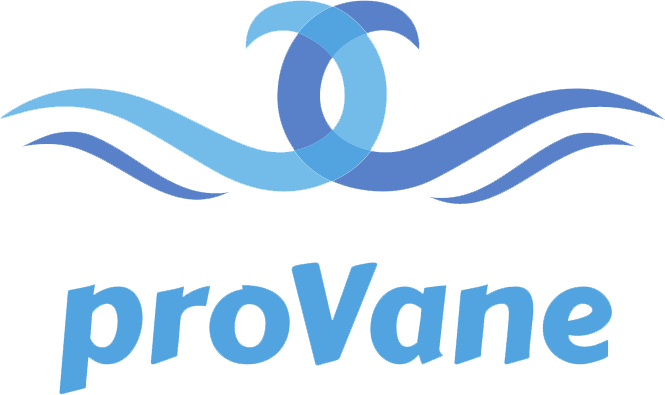

Tough, strong and reliable self steering

New Windy coming soon
Model Windy (servo-pendulum, currently not available) feedback and nice blog:
Sailblog Yacht Flirtie, Voyager 40 Blog1: https://www.sailblogs.com/member/distantdrummer/483079 Blog2: https://www.sailblogs.com/member/distantdrummer/483286 Blog3: https://www.sailblogs.com/member/distantdrummer/
About ProVane
ProVane is designed for a larger boat with wheel (also suits for tiller) and it has emergency rudder ability. ProVane can be mounted off-center.
It’s rudder is 300x1100mm and also the windvane is large, 520x1000mm. ProVane is stand alone system, auxiliary rudder type, no steering lines in cocpit for the wheel.
Advantages over electric autopilots:
- It does not require electricity for its operation.
- Robust and simple construction.
- Emergency rudder with tiller.
- Vessels rudder system does not wear on longer trips.
Dimensions PDF:
proVane dimensions
For better understanding user manual is downloadable by this link here (Google Drive):
Photos and videos
Take a closer look at our product

Make your sailing experience more enjoyable
Nb no new orders will take new orders in august. apologies.
Text goes here
Text goes here also
Selfsteering equipment idea was born while I was sailing around the world across three oceans on a 31-feet yacht.
On the last leg from South Africa to Cabo Verde, flight home being less than 4000 nm away, the old noname self steering gear broke down when a bigger breaker hit the yacht from the side.
This gave me a reason to start developing a new self steering system that would be stronger. The idea was to build the cheapest windvane on the market that would still keep its strength and quality. By now Windy windvane has successfully sailed across the Atlantic ocean many times.
S/Y Bellatrix
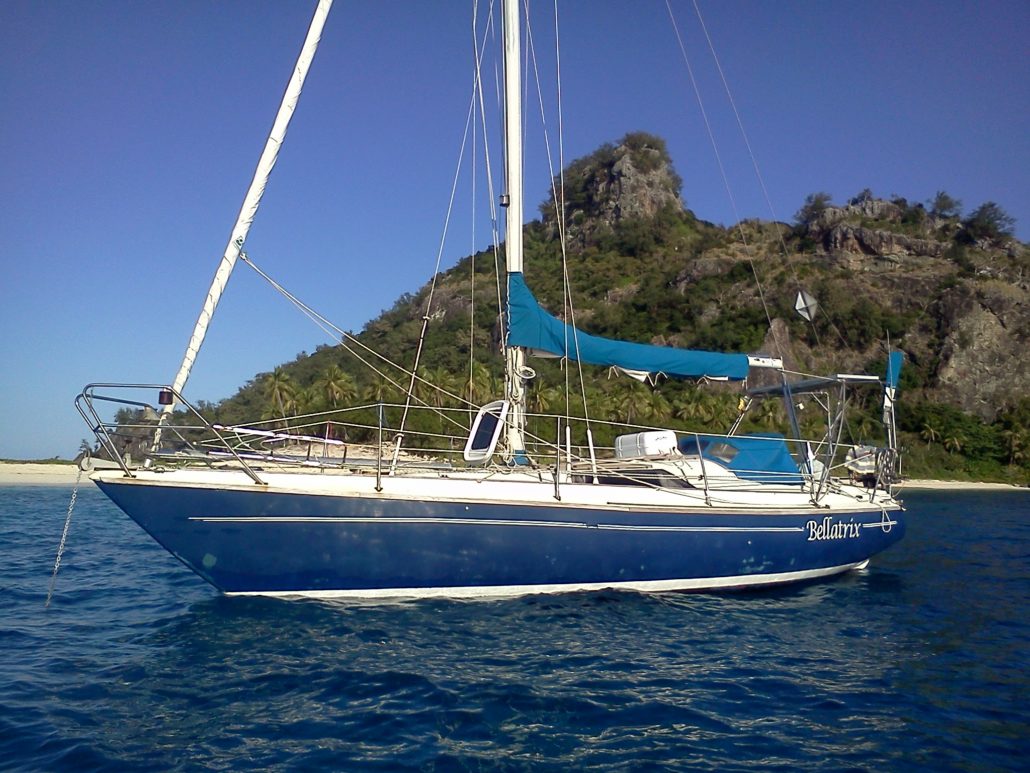
Got a question?
Silber Metallic OÜ
Registry code: 11574431
Address: Köömne 18, Tallinn, Estonia 10617
E-mail: [email protected]
Phone and WhatsApp: +372 5667 6656
Send us a message
- SAILOMAT 800
- SAILOMAT 760
- Designer's Comments
- Overall Description
- Main Features
- Technical Info
- Component Photos
- Installation Photos
- Questions and Answers
- Pricing Information
- User Comments
- Installation Examples
The ULTIMATE in Sailboat Self-Steering
SAILOMAT is the world's leading professional design team and manufacturer specializing in state-of-the-art mechanical self-steering systems for all cruising sailboats.
Universally acknowledged among world cruisers as the most advanced self-steering systems available – a SAILOMAT is a masterpiece of design and function. The very high strength, built-in simplicity, simple mounting, reliability, and long life make SAILOMAT Self-Steering the distinguished leader in its field.
The most recent design is the SAILOMAT 800/760/700 series, based on 40 years of self-steering design experiences , practical testing and manufacturing under the group leadership of Dr. Stellan Knöös, both in Sweden and USA. The state-of-the-art and innovative SAILOMAT 800 system represents the next generation in sailboat self-steering.
The Ultimate in Sailboat Mechanical Self-Steering Custom Design and Manufacturing Worldwide sales Factory Direct Since 1974. San Diego, California, United States www.sailomat.com [email protected]
- Autopilot the first self-steering gear
- Yacht Management News

- February 16, 2015
- by Siebert Yacht Management
Autopilot, the first self-steering gear was introduced in the 1920’s to control model yachts but it was not until 1948 that the principle was applied to full scale yachts. Standing at the helm for lengthy periods, monitoring instruments and keeping a good look out can be very tiring. An autopilot relieves the helmsman from steering the correct course leaving him free to maintain a proper watch. The autopilot can be set to either steer a compass course or a course relative to the wind. A fluxgate compass or electronic wind indicator feeds information to a microprocessor which then makes the necessary rudder movements to return the vessel to its required course. The mechanical power is applied to the rudder by electric linear activators, hydraulic pumps or rotary drives. GPS/Chart plotters can be used to input navigational instructions to the autopilot.
Battery Chargers will keep batteries fully charged thereby extending their working life.
Chart Plotters Typically a chart plotter consists of an antenna, mounted high on the boat, to track GPS signals and a display unit sited either at the at the navigation station or the helm of the vessel. The vessels position is sent from the antenna to the display unit which in turn shows it graphically on the chart. The Chart itself will look similar to its paper equivalent and show depth, land mass, navigational aids such as buoys and potential dangers in the form of wrecks and obstructions. The user can add way points to the chart and zoom in and out of the display. Chart plotters can be connected to drive an autopilot and/or send GPS data to a fish finder or radar. They can also interface with a laptop enabling complex passage planning to be done away from the boat and then entered into the chart plotter after arriving at the boat.
Magnetic Transmitting Compasses work like traditional compasses using magnets to determine the vessels orientation to the earth’s magnetic field they then transmit the boats heading to an electronic display. They make steering easier than with conventional compasses because they display steadier headings and do not suffer from the “lag” that occurs when making a turn. They can interface with chart plotters, autopilots and radar. Fluxgate Compasses consist of two pieces of readily saturated magnetic material with coils wound round them in opposing directions. AC current is passed through the coils and the material is saturated in one direction and then the other. The earth’s magnetic field affects slightly the time at which saturation occurs, earlier in one coil and later in the other. The difference is then calculated giving an output proportional to the earth’s magnetic field. They are accurate to 0.1 of a degree. Their output can be displayed digitally to the helmsman or they can interface with autopilots, chart plotters and radar.
Echo Sounders work on the same principle as sonar. A transducer emits a narrow beam of high frequency sound. This is reflected by any solid objects and the time between transmission and receipt of the echo is measured. The speed of sound through water is know and so the range or distance to the sea bed can be calculated. That is then displayed in meters. Forward Looking Sonar (FLS) enables you to see the underwater hazards before you’re actually on top of them. A typical range for a FLS is 150 meters.
An Emergency Position Indicating Radio Beacon (EPIRB) is a piece of equipment designed to float free of a vessel in distress. It then sends a radio signal that can be detected by Search and Rescue Satellite Aided Tracking (SARSAT) satellites. They relay a message to a ground station that in turn can instigate a search and rescue operation.
Fish Finders use the same technology as sonar. A narrow beam of high frequency sound is transmitted by a transducer; this is reflected by solid objects such as the sea bed. By developing this technology, fish finders provide displays that show where the fish are and they can differentiate between bait fish and larger species
Global Positioning System (GPS Receivers) – This system was originally designed for military purposes and is owned and operated by the United States Department of Defense. 24 satellites are arranged in a “birdcage” around the globe, they are positioned in such a way that at any place on the earth’s surface a direct line of sight can be established to a minimum of 4 satellites. A fix is obtained by measuring accurately the distance between a satellite and the GPS receiver at a precise time. Because the exact position of the satellite is known, these distances provide position lines which are converted by a microprocessor within the GPS receiver to read outs of latitude and longitude.
The log is used to measure the boats speed through the water. A paddle wheel or impeller, mounted below the waterline is turned by the flow of water; this generates electrical impulses that are fed to a microprocessor that displays both speed and distance run.
Inverters – On most boats today you will find domestic equipment of one sort or another. Live aboard boats might have a washing machine, dishwasher or microwave. Most boats have on board entertainment with televisions or stereo systems. The inverter can take 12v, 24v or 48v supply and convert it to a stable 110 v or 220v AC supply.
Navtex can perhaps best be described as a continuously updated telex service providing navigation and weather information within specified areas. An on board receiver, tuned to 518kHz, the worldwide Navtex frequency, if left turned on will either print out or display the latest massages sent from a local station. The service is available up to 400 miles from the coast.
Radar enables you to see what otherwise would be invisible. They offer greatest benefit at night and in fog or rain and are of particular value when close to shore or in busy shipping lanes. They consist of an antenna and a display. The antenna sends out a stream of RF energy which is reflected back off hard objects. When this energy is bounced back it is converted to a signal which displayed to the user. The antenna rotates every few seconds, the display continuously calculates the direction of the antenna and so a precise bearing to the target is calculated. The time is measured for the energy to be reflected and so the distance of the target is also displayed.
Satellite Phones consist of an antenna, a modem and a normal handset. They are powered by an iridium battery. Their range is anywhere covered by in Inmarsat Mini-M satellite. Voice, fax, email and data can be transmitted. Satellite TV requires an antenna and of course a television. Reception is available within a “footprint” which is based on EIRP (Effective Isotropic Radiated Power) of a transmitting satellite. The EUTELSAT together with the two ASTRA satellites cover Europe. NILESAT and the two ARABSATs cover Africa and the Middle East. Good coverage is also available in North, Central and Southern America.
SSB Radio has a range of several thousand miles. You will need an FFC license or the equivalent in whichever country you plan to operate it. Power consumption is a consideration. Up to 100 Watts may be required for transmission. SSB radio requires several items of equipment. A transceiver capable of SSB operation, An antenna, this must be 8 meters long and in practice most boats use a backstay or shroud for the purpose having fitted the necessary insulators. An antenna tuner matched to the transceiver model. If you want to send email you will also need and radio modem and computer.
VHF Radio the power required to transmit is minimal, all sets have the option of transmitting on either 1 Watt or 25 Watts and the lower power should be used whenever
possible. Unlike telephones that allow you to both talk and hear at the same time most
VHF sets require you to press a transmit button prior to talking. This is known as simplex. Duplex sets are available but are much more expensive. VHF radio waves travel in straight lines so the aerial should be mounted as high as possible, preferably at the masthead.
Florida Yacht Management
Subscribe to our newsletter, siebert yacht management.
- Jupiter Trade Center 2875 Jupiter Park Drive Suite #1700 Jupiter, Florida 33458 Monday - Friday: 8 AM–4:30 PM Saturday & Sunday: Closed
- [email protected]
- (561) 747-6499
Siebert Yacht Services
- Engine Service/Repair
- Electronics Sales/Installation
- Custom Refits/Upgrades
- Maintenance Services
- Management Services
- Captain Services
- Boatyard Services
- AC Service/Repair
- Custom Painting
- Carpentry Services
- Detailing Services
- Canvas & Upholstery Services
Authorized Dealer
- Volvo Penta Dealer
- Dockmate Dealer
- Clearline Electrosea Dealer
- Bluefin LED Dealer
- Garmin Dealer
- Intellian Dealer
- GOST Dealer
- SureShade Dealer
Authorized Service Center
- Sabre & Back Cove
- Volvo Penta
Our Commitment
- Meet the Siebert Management Team
- About Siebert Yacht Management
- Our Client Feedback & Testimonials
- Frequently Asked Questions
- Our Work & Photo Gallery
- For Sale/Wanted
- Readers Tips
- Your Yarns.
- Restoration
- Miscellaneous
DIY Boat Yards
- Boat Building
- Cabin Cruisers
- Free Boat Plans
- Begin Boating
- Boating Terms
- Ropes and Rigs
- Just for Fun
- Celestial Navigation
- Passage Planning
- Sailing Rigs
Wind Vane Self Steering Gear
A wind vane self steering system is not an essential piece of equipment on a sail boat.
However, for anyone who sails alone or cruises short handed over long distances the benefits can be immeasurable.
Long tricks at the helm are exhausting, concentration wanes, essentials such as eating, trimming sails, navigating, sleeping etc are neglected.
Besides that, with a self-steering system set and the sails trimmed you will have time to relax and really enjoy the ride.
- About Self Steering.
The Basic Mechanics.
Types of vane., building your own vane..
- Your Comments
Self Steering Wind Vanes
The first time that a wind vane was used to cross an ocean it was on a motorboat, or so I'm told.
Today however, electronic auto pilots are much more reliable at holding a course and the power to drive them is not an issue as most engines are fitted with alternators which constantly produce electricity.
However, a wind vane gear is best solution for a sailing boat and not just because of the power issue.
Wind direction offshore tends to remain relatively constant over long periods, but there are always constant minor variations and gusts.
In order to keep the sails drawing at maximum efficiency, while maintaining a set autopilot course, they would have to be constantly trimmed.
Wind vanes on the other hand will slavishly follow any wind shifts, a good one will often do it better than most humans and do it for hour after hour without tiring.
As well as not requiring any battery power, the windvane does not have any complex electronics which, will be vulnerable to damp and that are unlikely to be repairable without spare parts.
Many of the simpler vane gears can usually be repaired or rebuilt using non-specific parts and lashings.
And you can even build one by yourself.
Affiliate links
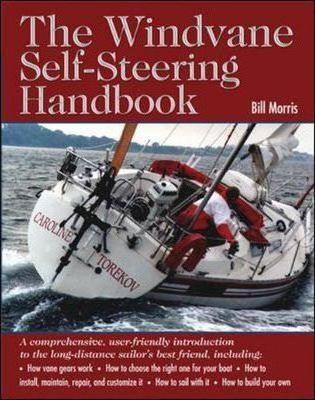
to Search for books on Self Steering from an Independent Book Shop Near You.
Prior to the development of windvanes long distance sailors such as Joshua Slokum and Eric and Susan Hiscock relied on their boat’s natural ability to bold a course.
Others used systems of blocks and lines between the sails and the tiller.
One of the most common used setups for downwind sailing was using poled out twin headsails, with the sheets lead back to the tiller so that when the pull on one sail increased, the tug on the tiller would bring the boat back on course.
These methods required the sails to be set for balance rather than speed, which is fine for the cruising sailor.
However, the increased interest in long distance short handed racing prompted the development of vane gears.
In the first Singlehanded Transatlantic Race in 1960 all five entrants used vane gear.
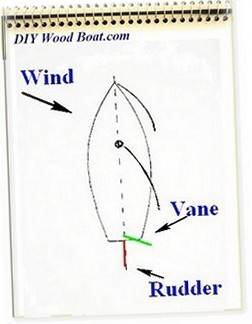
The whole point of a wind vane steering gear is to provide feedback to the rudder so that the boat can remain at a set angle to the wind, 'in the groove'.
- This will not be a steady compass course but a constant point of sail.
- First you sail the boat on the desired compass heading.
- Then you trim and balance the sails for this course.
- Once the boat is trimmed the vane is set and the gear engaged to steer the boat on that point of sail.
So how does it work?
There are numerous variations to the mechanics of the linkages types of vane etc but they all work on the same basic principle.
The vane is set so that it is feathering when the boat is in her groove.
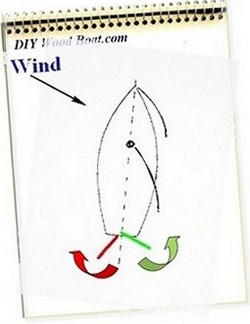
Any variation to this angle to the wind will cause the vane to rotate.
The linkages then transmit this rotation to the rudder in such a way as to bring the boat back on the desired heading.
With the boat back on its correct heading the vane and thus the rudder will return to its original position.
In theory the vane could be mounted anywhere where the wind across it is unobstructed.
However it has somehow to be connected to the rudder by some form of mechanical linkage, so the most logical position for it is on the transom.
And it is the linkage which performs the magic.
When the boat drifts off the wind the vane will rotate or flip with the wind, this movement then must be transmitted to the rudder as a turn in the opposite direction.
In the case of a simple vertically rotating vane, as the boat turns clockwise away from the wind direction the vane will rotate in and anti clockwise direction relative to the boat.
This rotation then needs to be transmitted to the rudder to turn it clockwise, relative to the boat, this will then turn the boat anti clockwise until she is back in the groove.
Once set up a vane gear can be very effective.
Setting up is however a matter of getting the balance correct.
Like your sails the wind vane needs to be set according to the apparent wind, the sails rudder and vane need to be in balance.
Because the vane is subject to the apparent wind it will be less effective on a run and in light airs.
In the very simplest of self steering vane gears as the vane pivots the movement is transmitted via lines directly to the tiller.
On others the vane acts directly on a secondary rudder.
However the force provided by a wind vane alone is rarely sufficient to make this system work with large boats.
To overcome this, variations such as the servo pendulum system, invented by "Blondie" Hasler have become widespread.
These systems harness the power derived from the motion of the boat through the water to help turn the rudder.
- Vertical Trim-tab
- Horizontal Trim-tab
- Vertical Servo-pendulum
- Horizontal Servo-pendulum
Vertical-Vane Trim Tab.
This is without doubt the easiest wind vane self-steering device to understand and build.
The vane is vertically pivoted and controls a trim tab on the rudder.
This can be either the main rudder or an auxiliary one.
I had this type of gear on my previous boat and it took me far and wide.
It isn't the most accurate of gears however with some judicious use of bungee to dampen any tendency to yaw it served me well.
Not only is it simple to build and operate but its very simplicity gives it an uncomplicated elegance.
When I built the new rudder for Mignonne I designed it so as to incorporate the vane gear.
Horizontal-Vane Trim.
This horizontal vane gear also operates on a trim tab.
However the vertical vane is set by turning it on its turret until the vane stands as nearly vertical as possible.
Because it tilts proportionally to strength as well as direction of the wind it is a more powerful version of the vertical-vane.
And there is less tendency for the boat to yaw.
Vertical- Vane Servo-pendulum.
On the vertical-vane servo-pendulum invented by Blondie Hasler, the vertical wind vane is connected to the servo blade.
As the pendulum, or servo blade, is turned by the vane it is forced aside by the its movement through the water.
It is this force which is then transferred to the tiller or wheel by means of the linkage.
The main advantages are that the stronger the wind, the faster the boat speed, the greater is the force is applied to the rudder.
Horizontal- Vane Servo-pendulum.
The servo-pendulum with a vertical wind vane has become the standard for most commercially produced wind vane systems.
While there are differences in their methods of transmission, the basic principle is the same.
The most popular among cruising sailors is the Monitor because of its rugged construction and because most parts can be fabricated and repaired relatively easily.
While these commercially produced systems are robust, perform silently and very near flawlessly on all points of sail, they are very expensive.
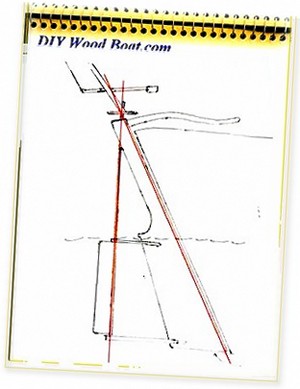
The easiest and least expensive type of boat to fit a wind vane to is one like Mignonne which has a transom-hung rudder and tiller.
This uses the vane to control a small trim tab on the trailing edge of the main rudder.
The trim-tap controls the main rudder in the same way a trim-tab works on an aeroplane wing.
As the tab turns in concert with the vane, the rudder is deflected in the opposite direction thus turning the boat.
If you are designing your own vane, whatever the style there are several details to keep in mind.
- The vane must be as sensitive as possible, which usually means large and light.
- Friction must be kept to a minimum, preferably with non corrosive bushing such as Teflon.
- The tab needs to be narrow and deep yet clear of the bottom of the rudder to avoid damage.
- Whatever linkage you use should not be affected by movement of the main rudder.
The vane I have used on Mignonne was inspired by an idea from one of Lin and Larry Pardey’s books.
Rather than use the usual plywood panel I made a wooden frame to support a sailcloth vane.
My vane like the rest of the boat is still very much a work in progress and the present vane really needs to be larger, I knocked it together from off cuts and leftover bit of sailcloth.
However, creating it to look like a small mizzen sail has the added advantage of fitting it into the overall look of the boat.
Also the light weight needs less of a counterbalance.
My main fear from using a trim-tab was how it would be affected when motoring astern.
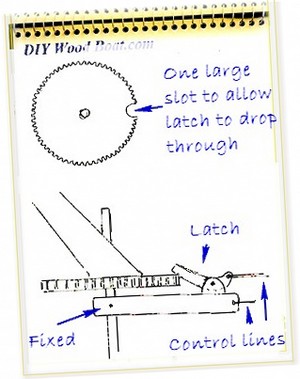
The usual advice is to have a locking device to center the tab, but I know from experience how easy it is to forget something like that until it is too late.
So what I have done is attack the tab with enough clearance between it and the trailing edge of the rudder to allow it to rotate through 360 degrees.
This type of trim-tab also seems to work best where there is an angle between the axis of the rudder and tab pivots and if the linkage is sited where these cross.
Because the trim-tab turns in the same direction as the vane the linkage is direct.
The only provision needed is a method of allowing the vane to be set according to the wind direction.
I used a disc of a Tufnol like material which was relatively easy to shape yet is hard wearing, I have heard of someone who used a bicycle drive cog to good effect.
The latch is just a piece of metal hinged so that its own weight causes it to engage and it is controlled with a simple lanyard.
My greatest fear about using the wind vane is if I should fall overboard and have to watch my boat merrily sailing away form me.
OK, that can happen without self steering which is why I always (well nearly always) clip on when I'm sailing alone.
I have read suggestions about trailing a long line with a float on the end, umm, that’s ok if you are able to swim to it in time to catch it, I’ll stick to my harness and safety-line thanks.
And remember that while a wind vane might do a great job of helming your boat it won't keep a lookout, that’s still your responsibility .
However, I have found that being relieved of the need to helm allows me more time to look around.
And on the subject of looking around don’t forget that extra bit of gear sticking out of the transom when docking mooring and going astern.
Also remember that your vane can only react after the boat has moved off course, it isn’t able to anticipate the sea conditions or wind shifts.
If you do need to make an emergency course change the wind vane mechanism should be easy to disengage.
Previous posts
See What Others Have Posted

Recent Articles
WANTED: Long lost Chris Craft 26 feet
Jan 29, 24 01:35 AM

"Only by going alone in silence, without baggage, can one truly get into the heart of the wilderness. All other travel is mere dust and hotels and baggage and chatter." (John Muir, naturalist, explorer, and writer,1838-1914)
You might like these

Anchor Types
Anchor types, how to choose the type, size and style of ground tackle, chain and rode to anchor your boat safely.
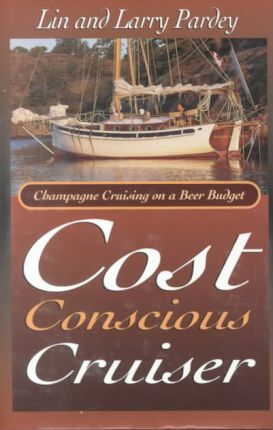
Cruising in Wooden Boats, the Eco Lifestyle
Freedom wooden boat Cruising, adventure, boat handling, navigation safety for wood boat builders.

Anchoring Techniques
Anchoring techniques, best practices to ensure the safety of you and your boat, and how to retrieve a snagged hook.

DIY boat yards, do you know of or are looking for facilities and hard standing where wooden boats are welcome and where owners can do their own thing free from bureaucratic harassment.
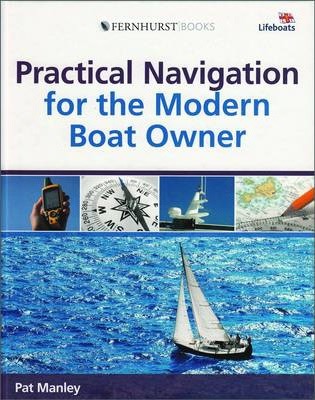
Passage Planning for Small Boat Cruising
Passage Planning, a concise and easily understood cruise plan, for any of voyage from a dinghy trip around the bay to, cruising boat navigating an ocean.

Free Energy
Free Energy, electricity on board your boat and battery charging from the wind or solar a comparison.
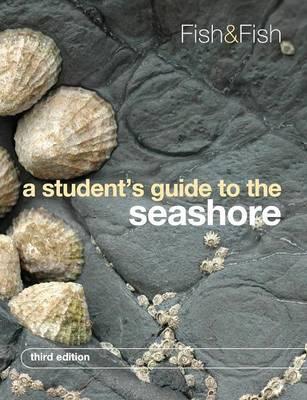
Foraging for Shellfish
Foraging for Shellfish, the original fast food, for taste, nutrition and availability, edible seafood from the seashore is hard to beat.

Overcoming Seasickness
How to overcome seasickness, mal de mer or motion sickness a review of some of the remedies, medications and natural precautions.

Edible Seashore Plants and Seaweed
Edible Seashore Plants and Seaweeds are free for the forager to gather, they tasty, nutritious foods that provide the perfect accompaniment to any seafood dish.
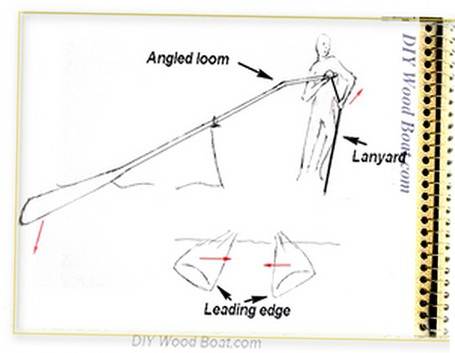
Sculling a Boat with a Single Oar.
Sculling, how to propel a boat or dinghy using one paddle or Chinese Yuloh at the transom.
HELEN M HOBART
Jan 21, 24 05:31 AM
Drain plug for wooden hull
Dec 28, 23 11:28 AM
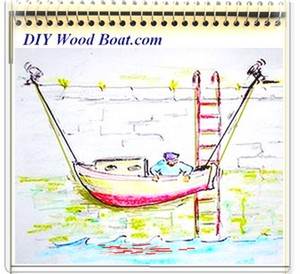
Rule of Twelfths for Quick Tidal Estimates
The rule of twelfths and the rule of tenths are easy rule of thumb calculations for quickly working out the approximate tidal stream and tide height from marine tide table predictions.
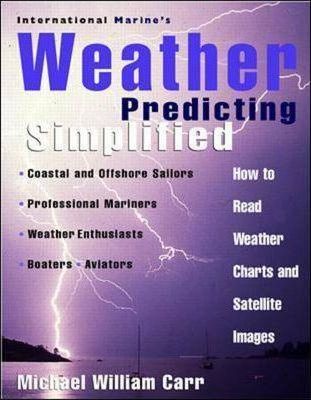
Weather Sayings
Weather sayings, worth remembering, sailors use phrases, expressions and idioms for short term forecasting, many have scientific explanations.

Maritime Weather Patterns
Global weather patterns influence your local marine conditions, understanding how these work will help you to interpret forecasts, help to keep you safe and your boating enjoyable.
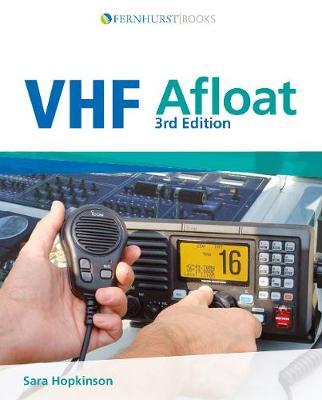
VHF Marine Radio
Description of VHF Marine Radio Equipment for the average boater, types of transceiver, range and restrictions.
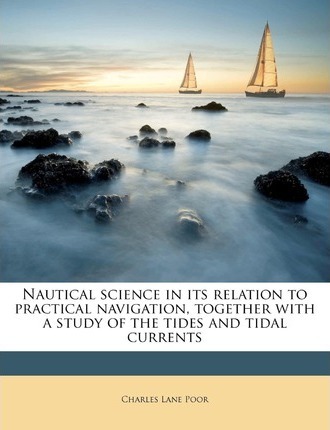
Tides, how they are caused and predicted.
Tides, tidal streams, sea level predictions and marine currents and what the leisure boater should know about Tide tables, charts coastal height prediction data.
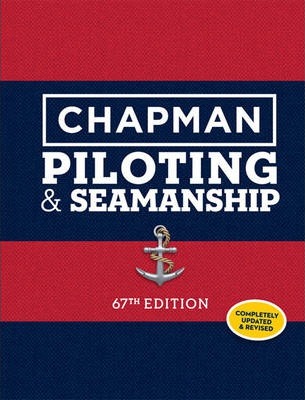
Tide Gates and Navigation.
Tide gates, currents, overfalls and tide races what to watch out for when planning coastal navigation.

Polaris the Navigator's Star
How to use Polaris to determine the direction of north, probably the oldest form of celestial navigation in the northern hemisphere.

Pilotage Planning, the Art of Coastal Navigation
Pilotage planning, tips and techniques for small boat, inshore navigation, buoy hopping, night sailing and entering and leaving port.
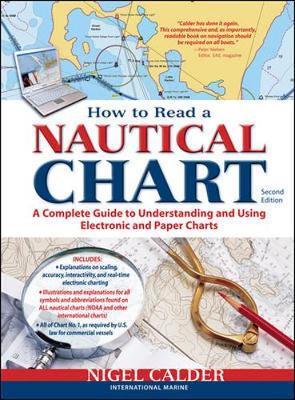
Marine charts for Navigation.
Marine charts are essential for boat navigation a sea either as paper charts or electronic charts for the information the navigator must have.
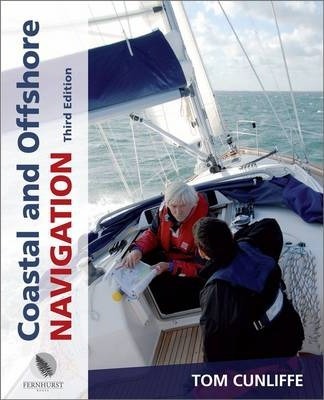
Tidal Stream Vectors for Boat Navigation.
Tidal stream and currents, how they affect boat navigation, estimating position and determining course to steer
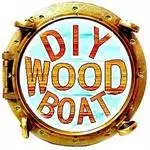
Privacy Policy
Advertising Policy
Cookie Policy

I am perfectly aware that the majority of Wooden Boat aficionados are sensible folk. However, I need to point out that I am an amateur wooden boat enthusiast simply writing in order to try to help other amateur wooden boat enthusiasts. And while I take every care to ensure that the information in DIY Wood Boat.com is correct, anyone acting on the information on this website does so at their own risk.

Specifications
CONFIGURATION BY BOAT TYPE
This is a listing of some of the boats we have provided a Hydrovane for, showing the configuration used (Shaft Length, Upper Bracket, Lower Bracket). Please note that the same model boat does not necessarily use the same configuration – there are variables such as aerial obstructions and other boat-specific factors.
OVERALL DIMENSIONS
This schematic may be helpful for you to understand the fit requirements for the Hydrovane. We want to position the Hydrovane tiller at an appropriate height while also ensuring that the Vane has enough airspace. This schematic shows our Standard Vane.
The Drive Unit
Today’s Drive Unit is the VXA1 / VXA2 Model.
Both are variations on the only model available today, and since 1986. The majority of Hydrovanes sold are the VXA2 model; the remote course setting capability is well worth it. A VXA1 may be suitable for a smaller cruising boat with an arm’s reach from the cockpit to the Course Control Knob.
The Drive Unit is where the magic happens… it is the sophisticated linkage mechanism that multiplies the forces on the vane by many times.
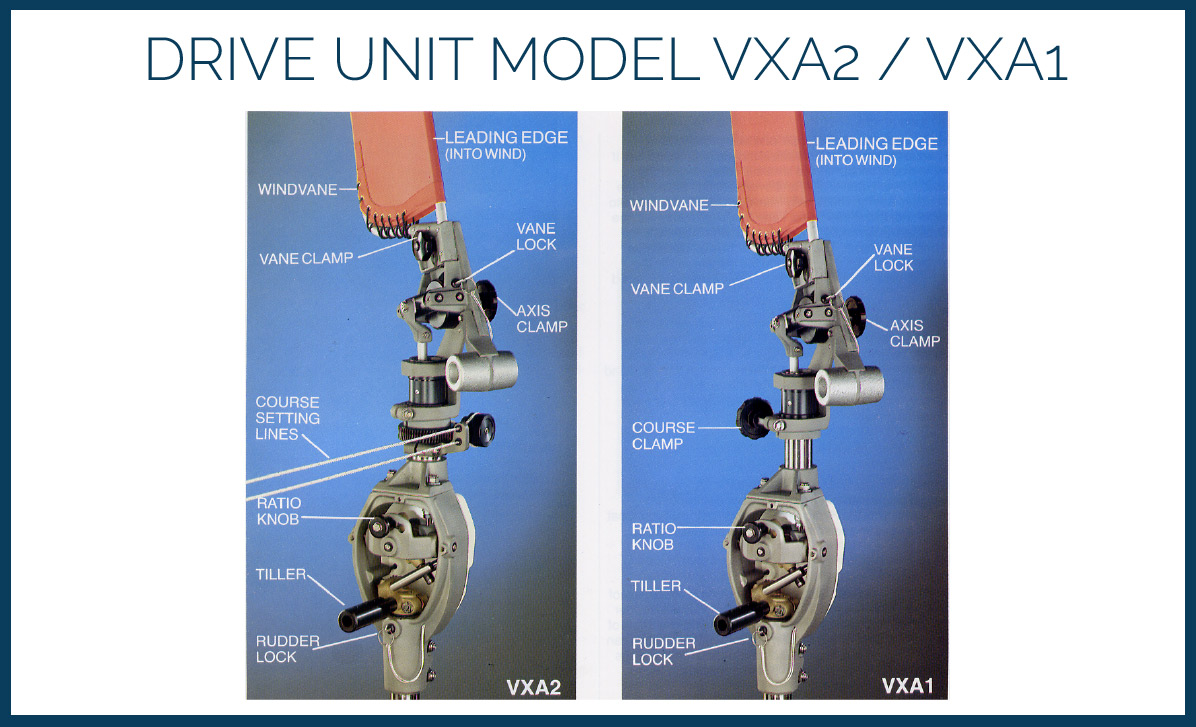
The Shaft Assembly
The Hydrovane shaft assembly includes the shaft, the outer tube, and shaft bearings.
Older units: The shaft outer diameter will be either 1 1/8 in (28.575 mm) – out of production since 2002 – or 1 ¼ in (31.75 mm).
Since early 2009, all shafts are made of solid 1 ¼ in Ferrinox 225 ‘Super Duplex’ stainless steel – three times as strong as ‘316’.
All shafts are machined to 1 in (25.4 mm) at the top.
The tube has a 2″ outer diameter.
Shaft Required
The length required depends on the stern height, and if there are any aerial obstructions. The table below shows the required shaft length, assuming that for free vane movement the stern rail is not more than 24 in (610 mm) above the deck and does not project aft of the stern. Otherwise, the next longer shaft may be needed.
Shaft Lengths
These measurements are from tip to tip of the inner shaft. When the Drive Unit is fitted onto the shaft, about 8 inches (203 mm) of the shaft assembly is covered.
*In 2018 we added an extra 3mm to the top of the shaft (the part that is machined to 1″ OD). Below are the original tip to tip measurements.
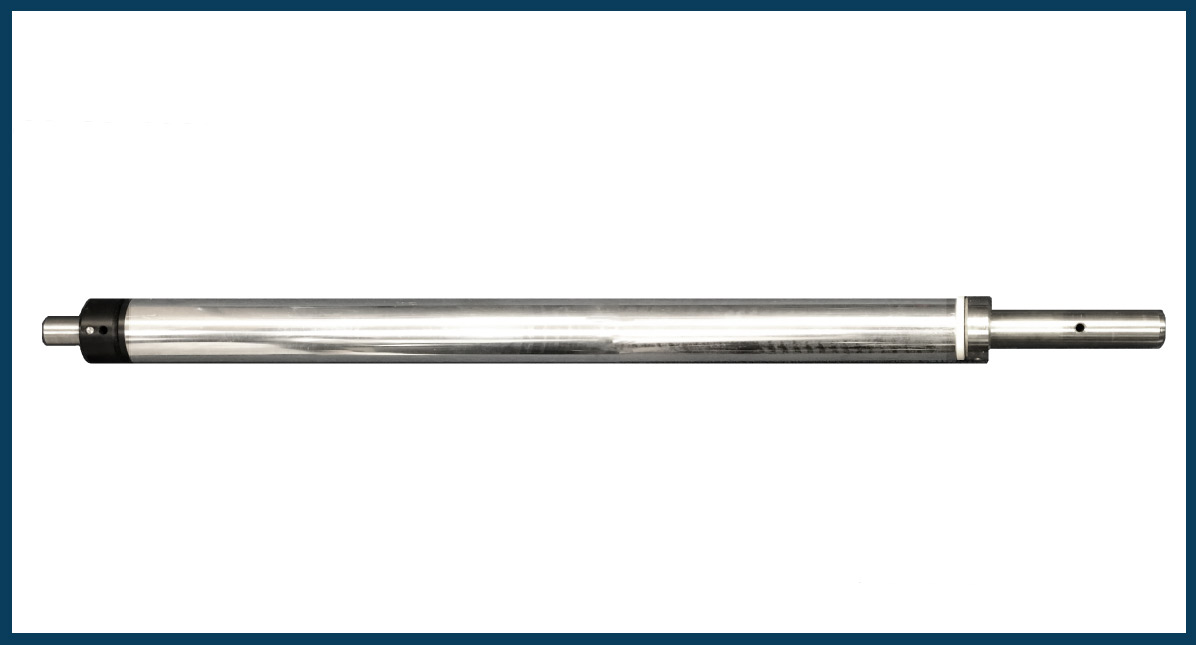
The Hydrovane vane needs a lot of airspace – can be as tall as 12 ft / 4m above the water and more importantly it has a lateral reach of over 4 ft / 120 cm. in all directions at that height – yes, a full 360 degrees!
If your boat has:
- Bimini that reaches aft
- Arch supporting solar panels or communication gear
- Radar post/mast
- Wind Generator
- Any other aerial obstacles but not davits (normally are low enough)
…then we need photos taken at 90 degrees to the transom and from dead aft – showing from the water to the top of those obstacles – in order to properly configure an installation.
Boats with any of the above aerial obstructions often use the Stubby Vane.
Our newest Vane – the Extendable ‘XT’ vane – has many benefits, including more leverage/power, and the ability to be ‘reefed’ in heavy weather or on a certain point of sail if there is an aerial obstruction.
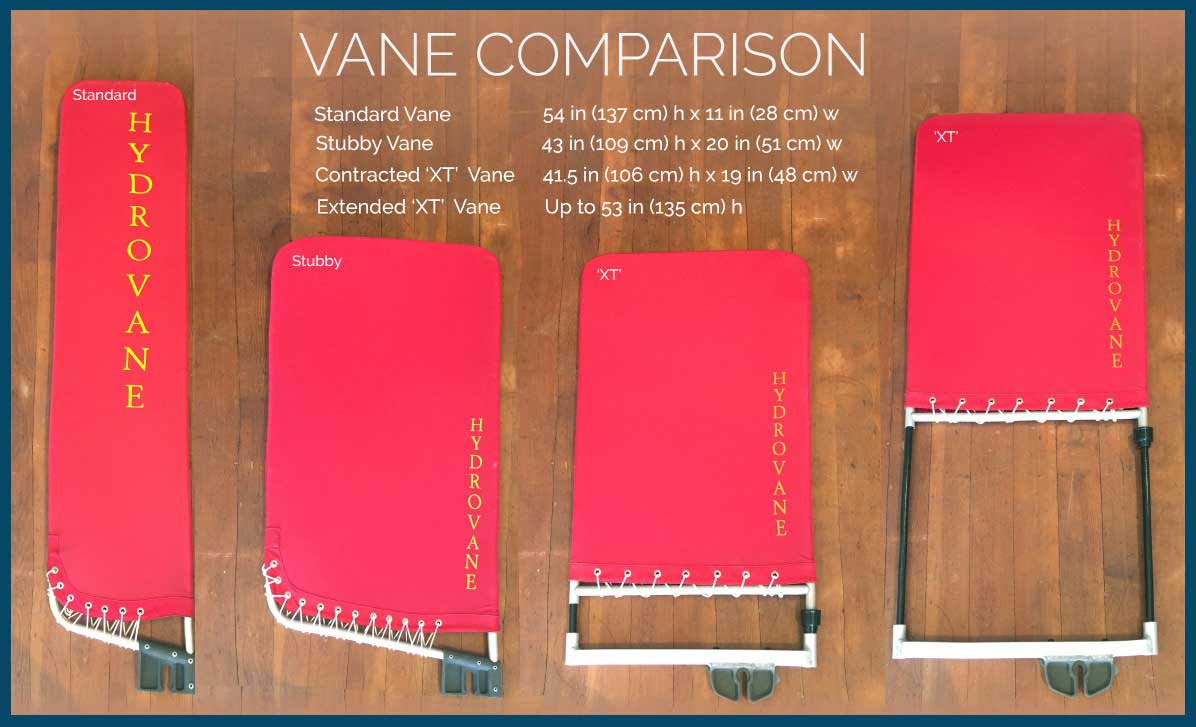
THE Brackets
Every installation requires two brackets – a combination of the three brackets we manufacture. The brackets required are entirely dependent on the transom of your boat.
H ‘Hinged’ Bracket
Every installation must have at least one H Bracket. The ‘H’ bracket is located at about the closest point from the shaft to the stern.
E ‘Elbow’ Bracket
This is the single strut bracket. It can be more difficult to install, but is less expensive than the A bracket.
- It is the only bracket without a hinge, meaning the angles are fixed and must be accommodated by using timber pad(s) to accommodate the contour of the hull and the difference in angles.
- Fixed Angles – Each of the castings at either end of the Strut (Stay Tube) hold the tube at an angle of 15 degrees. The result, depending on the direction the castings are positioned, creates aggregate angles of either 30 (15 + 15) or zero (15 – 15) degrees.
- The Strut is provided at a maximum length of 18”, to be cut down to required length.
A ‘Double Strut’ Bracket
The A bracket is our biggest, strongest, and most versatile bracket. The A bracket solves the most difficult installation issues.
- Arms swing up or down vertically
- Arms open in or out from 40 to 80 degree separation (as of summer 2013 – prior model fixed at 40 degrees)
- Transom attachment flanges fully rotate to become flush with any surface.
- Strength – Engineers love triangles
- Struts/tubes can be cut to any length. Struts are provided at 31”, to be cut down as necessary. Some installations require even longer tubes, which we can provide.
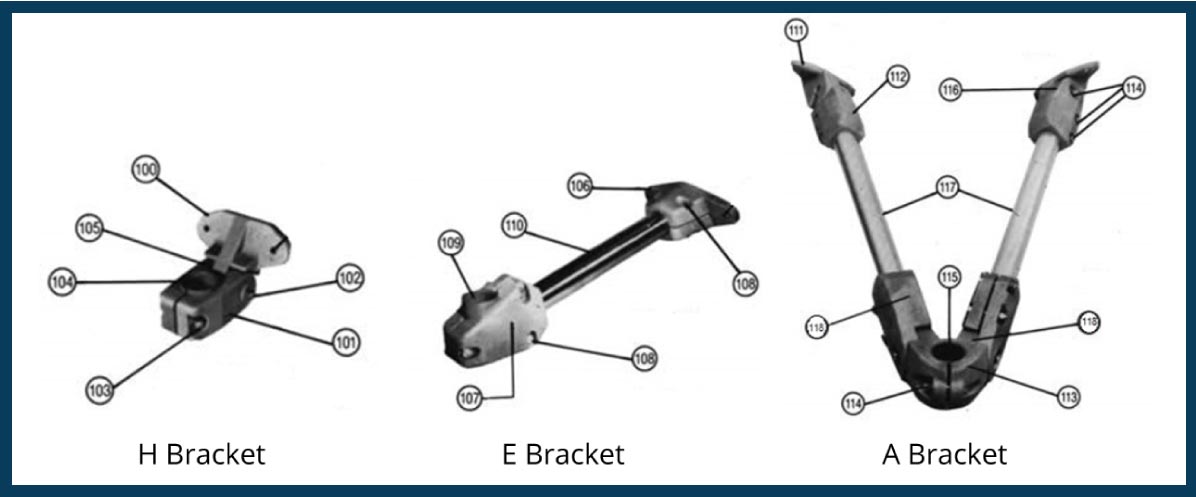
Mounting Pads
A Mounting Pad is a shaped piece of non-ferrous material (often teak wood or a synthetic like G10 Micarta or High Density Polyethylene – HDPE – is used) that is fitted between the bracket flanges and the transom. The Mounting Pad is fashioned or shaped to pick up any contour differences between the flat flange face and the transom.
Mounting Pads may not be necessary for your installation – if the transom is perfectly flat.
We offer Mounting Pads in either Timber (teak) or Plastic (HDPE).
Making and shaping the pads can often be the most difficult part of the installation. If you choose to make your own, please find the templates below.
For shaping the pads, read the tips in our Installation Guide.
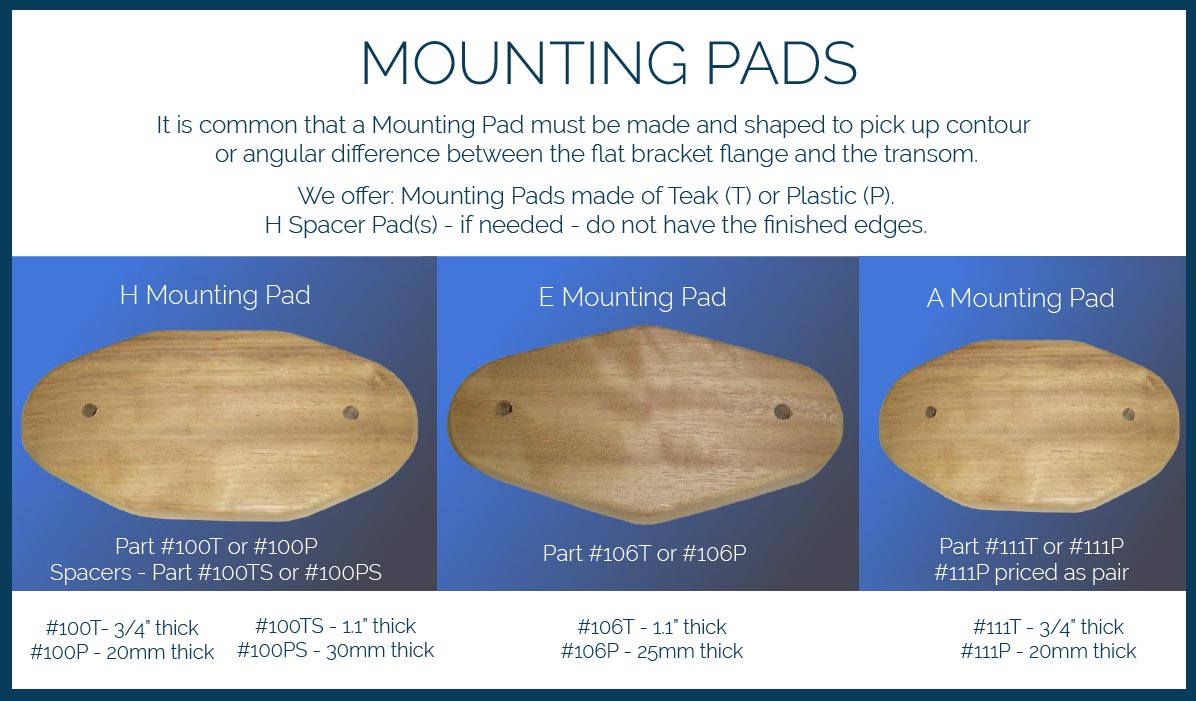
MORE INFORMATION
Helpful measurements.
- H bracket creates a distance from shaft to transom of between 1.5 in (3.8 cm) to 4.5 in (11 cm)
- The minimum distance required for an E bracket is 8in (20 cm)
- The minimum distance required for an A bracket is 16in (40 cm)
- The maximum exposed shaft between the top bracket and the drive unit is 18 in (46 cm)
- Space, distance between the bottom bracket and the bottom bearing: between 2 in and 10 in (5 cm and 25 cm)
- The minimum separation between the two rudders should be 8in (20 cm)
- Lighter – 66 lbs (30 kg) – S/H/H
- Average – 83 lbs (37 kg) – L/E/H
- Heavier – 113 lbs (51 kg) – X/A/H
- Shafts, axles and fastenings: 316 (EN58J) stainless steel except the main shaft which is Ferrinox 255 (Super Duplex), solid stainless
- Castings: LM25 anodized aluminum alloy and silicon bronze
- Bearings: Glass Filled PET, PFTE and Acetal (Delrin). Nylon ball race on rudder shaft.
- Rudder: Solid N6 nylon casting. Tapered NACA profile
- Wind Vane: Reinforced nylon cloth (ripstop) on anodized alloy tube frame
- Course control: 4 in (100 mm) oilon worm gear
The home of the worlds best R/C Model Aircraft Designers
UK Manufactured to order: Guaranteed Quality

Products search
Login FAQ
[email protected] +44 (0)1684 311682
- Unorthodox Aircraft
- X-List Plans (Aircraft)
- F/F Sport & Competition
- C/L Aerobatic
- Round The Pole
- All Aircraft Plans not yet categorised
- All Short Kit (Sets)
- Scale Short Kit (Sets)
- Sport Short Kit (Sets)
- Depron Short Kit (Sets)
- All Laser Cut Wood Packs
- Scale Laser Cut Wood Packs
- Sport Laser Cut Wood Packs
- All Additional Wood Packs
- Scale Additional Wood Packs
- Sport Additional Wood Packs
- Private & Trainer aircraft
- Transport Aircraft
- WW1 Aircraft
- WW2 Aircraft
- Static Aircraft Wood Kits
- All Aircraft Parts
- ABS Sets & Fairing
- Cowls & Nacelles
- Intakes & Rads
- Spats & Undercarriage
- Spinners & Prop Nuts
- Cliff Charlesworth Cowls
- All Canopies & Screens
- Cliff Charlesworth Canopies
- Jilles Smits Canopies
- Pat Teakle Canopies
- Guns, Sights & Cockpits
- All Materials
- Depron Foam
- All Covering & Tools
- DiaCov 1000 Covering
- Lightweight Tissue
- All Perma-Grit Tools
- Sanding & Filing Tools
- Rotary Tools
- Cutting Tools
- Screwdrivers
- Hex Wrenches
- Clamps & Pliers
- Airbrushing
- Lighting & Magnification
- Marking & Measuring
- Covering Materials & Tools
- RTF Aircraft
- ARTF Aircraft
- Free Flight
- Books & Specials
- DVDs & Blu-Ray
- Bargain Aircraft DVDs SAVE!
- Full Size Focus CD
- Line Drawings
- Model Aircraft Magazine Plans
- Cabin Cruisers
- Coastal Forces
- Fishing Boats
- Paddle Steamers
- Leisure Craft
- Scale Traditional Craft - British Isles
- Merchant Vessels
- Scale Traditional Craft - Non British Isles
- Passenger Ferries
- Steam Designs
- Patrol Launch
- Rescue & Lifeboats
- Working Boats & Ships
- Traditional Craft - British Isles
- Traditional Craft - Non British Isles
- Racing Sailing Boats
- Sport Sailing Boats & Yachts
- Scale Sailing Boats & Yachts
- Competition Powerboats
- Competition Powerboats - IC
- Competition Powerboats - Electric
- Easy to Build Boats
- Engineering
- Hydroplanes
- X-List Plans (Boats)
- All other Boat Plans & not yet categorised
- All Plan & Hull Sets
- Sailing Plan & Hull Sets
- Motor Boat Plan & Hull Sets
- David Alderton Plan & Hull Sets
- All Boat Short Kit (Sets)
- Sailing Short Kit (Sets)
- Motor Boat Short Kit (Sets)
- All Boat Laser Cut Wood Packs
- Sailing Laser Cut Wood Packs
- Motor Laser Cut Wood Packs
- Sailing Additional Wood Packs
- Motor Additional Wood Packs
- All Boat Additional Wood Packs
- All Static Model Boats
- Narrow Static Boats
- Motor/Steam Static Boats
- Sailing Static Boats
- Working Static Boats
- RC Boat Kits
- Ready To Run Model Boats
- Boat Fittings
- Electronics (Boats)
- Hulls (FG & ABS)
- Plastic Materials & Parts
- Airbrushing (Boats)
- Rotary Tools (Boats)
- Internal Combustion Engines
- Steam Engines & Plant
- Workshop Equipment
- Model Railway Plans
- All Engineering Plans not yet categorised
- Military Vehicles
- Maintenance Trays
- Scale Model Boats
- Scale Model Buildings
- OO Gauge Parts & Kits
- O Gauge Parts & Kits
- HO Scale Parts
- White Metal Fittings
- Airbrushing (Engineering)
- Rotary Tools (Engineering)
- Engineering DVDs & Blu-Ray
- All Covering
- DiaCov 1000
- Sanding & Filing
- Aircraft Books & Specials
- Aircraft DVDs & Blu-Ray
- Bargain DVDs SAVE!
- Boat Books & Specials
- Boat DVDs & Blu-Ray
- Books & Specials
- Chargers & Leads
- Control Boards & Accessories
- Hot-end Parts/Kits
- Motors/Drivers
- Teeth, Wheels & Bearings
- VORON Parts
- Automotive Parts
- Crafts & Games
- Electric Scooters
- Medical / Health
- Shot Glass Trays

30 years Experience
Of Scratch Building & Modelling The Home of the Model Builder
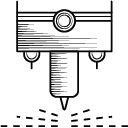
Made in our Workshop
Laser Cut & Printed to Order Guaranteed Quality & Detail

BRAINE AND VANE STEERING
Two sheets showing full working drawings for a variety of steering and sail control devices for vintage restored and replica yachts of all types.Most diagrams are fully dimensioned for reproduction by competent model makers.Designed by G W Clark.
Specification
Full description.
Featured in July 2001 Marine Modelling International
You must be logged in to post a review.
- 5 stars( 0 )
- 4 stars( 0 )
- 3 stars( 0 )
- 2 stars( 0 )
- 1 star( 0 )
This page uses frames, but your browser doesn't support them.
- BOAT OF THE YEAR
- Newsletters
- Sailboat Reviews
- Boating Safety
- Sailing Totem
- Charter Resources
- Destinations
- Galley Recipes
- Living Aboard
- Sails and Rigging
- Maintenance
- Best Marine Electronics & Technology

Self-Steering—with No Strings Attached
- By Darrell Nicholson
- Updated: February 4, 2002
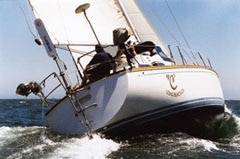
C02DN01.jpg
Although servo-pendulum windvanes, which we covered last month (“Sorting Out Self-Steering Options,” January), remain the most popular type of windvane self-steering system, other designs fill an important niche. Some sailors prefer the direct mechanical linkages–so there are no steering lines to the cockpit–that these other systems feature, and some boats simply wont work well with servo-pendulum designs.
The alternative designs fall into two categories: trim-tab systems, which work with the boats rudder, and auxiliary-rudder systems, which steer with their own built-in rudders. These windvanes feature the same three major components as the servo-pendulum designs we reviewed–sensor vane, underwater course-correction unit (servo-rudder), and linkages.
The servo-pendulum windvanes we reviewed use low-stretch lines led through blocks to connect a vanes powerful pendulum-rudder to the boats tiller, wheel, or steering quadrant. In the trim-tab and auxiliary-rudder systems well look at, the linkage to the boats rudder or auxiliary rudder is mechanical, an arrangement that avoids problems of excessive stretch, chafe, or incorrect tension but can introduce corrosion problems and linkages that have their own complications. For owners of center-cockpit boats, the direct linkage eliminates the need for long lines running across the afterdeck.
The boats that stand to gain the most from such systems are ones with hydraulic steering or with wheel steering having four or more turns between stops, ones with high freeboard, or ones that are otherwise incompatible–or less compatible–with servo-pendulum steering vanes. In most other cases, servo-pendulum vanes offer undeniable advantages.
Trim Tabs Like the flap on an airplane wing, a trim tab is the trailing edge of a larger foil–in our case, either the ship’s primary rudder or an auxiliary rudder. When directed by the vane sensor, the trim tab turns. As long as the boat is moving fast enough, the lift provided by the change in water flow provides the force necessary to move the larger rudder. A trim tab should be balanced (meaning that its leading edge is forward of its axis of rotation), so that it’s easily driven by the vane sensor, and appropriately sized, so it provides sufficient power to control the rudder. Friction at its pintles and gudgeons should always be minimal.
Few of the trim-tab units we’ll review can be lifted easily out of the water or quickly removed from the rudder, a common shortcoming among both trim-tab and auxiliary-rudder systems. This not only makes the underwater unit more difficult to maintain and more vulnerable to damage, corrosion, and fouling; it also can add an unexpected twist when backing a boat under power. The biggest drawback of a traditional trim tab is that it can’t produce the same amount of power as a pendulum rudder of the same size, so a boat’s sail trim and helm balance become even more important. Heavy-displacement vessels with unbalanced rudders can make the trim tab’s job particularly tough. For emergency steering, you can use a trim-tab system that connects to the main rudder as long as the rudder to which it’s attached is intact and is still capable of turning (as in the case of a broken steering cable, for example).
Sayes Rig: The Sayes Rig is one of the few production windvanes that still uses a flag- type vertical-axis vane sensor, which functions like a masthead wind indicator, rotating so that its leading edge always points into the wind. A vertical-axis vane, however, cant generate as much force as a horizontal vane of the same size. Nevertheless, the Sayes Rig manages to provide an efficient steering impulse with a powerful wedge-shaped cloth vane. One reason the Sayes can get away with a relatively small vertical-axis vane is that the trim tab it commands is a very small, well-balanced, servo-pendulum rudder, which provides far more power than a conventional trim tab of the same size. The linkages are simple: The pendulum rudders shaft passes through an extended U-shaped tiller arm attached to the boats rudder. The longer tiller arm, the more power it provides, so it works best on boats with inboard rudders. The simple design allows for durable construction in 316 stainless steel and cast bronze.
Auto Steer: This system, made in England, is easily adapted to boats with outboard rudders. Through a simple acetal-plastic and silicon-bronze universal linkage, the horizontal-axis sensor vane connects to a custom-sized trim tab made of wood and stainless steel attached to the boats rudder. The Auto Steer trim-tab vane is made of LM25 aluminum castings and 316 stainless steel, with insulation between dissimilar metals to minimize galvanic action. The manufacturer, Hydra Engineering, doesnt recommend the system for heavy-displacement boats over 35 feet. For larger boats, the company makes a more powerful servo-pendulum unit.
Auxiliary Rudders An auxiliary rudder, because it’s smaller and often better balanced than the boat’s main rudder, reduces the resistance to the steering impulse, which, in the models we’ll look at, is delivered by either a trim tab, the vane sensor, or a servo-pendulum rudder. Because they operate independently of the boat’s rudder, auxiliary-rudder systems are compatible with hydraulic steering. They are also capable of serving, in a limited way, as an emergency rudder.
When selecting an auxiliary-rudder system, carefully consider proper rudder size and how it’s attached to the boat. Although the boat’s main rudder will be used to compensate for weather helm, the auxiliary rudder still needs to be powerful enough to steer the boat before a high quartering sea. Attachment points at the hull should be well reinforced, and the rudder shaft should be rugged. These details are particularly important if you need your auxiliary rudder to serve in an emergency. Heavy-displacement boats that are difficult to steer can test the limits of an auxiliary rudder that’s required to steer in an emergency. Auto-helm: This system features a large, wedge-shaped, horizontal-axis vane sensor made of 6061 T6 anodized aluminum that’s linked to a trim tab on an auxiliary rudder. The rudder mounts and underwater fittings are made of 316 stainless steel. The easily turned trim tab helps amplify the relatively weak wind impulse into a force that can drive the auxiliary rudder. The unique cable linkage (similar to a bicycle’s brake cables, but with smooth Teflon sheaths) between the sensor vane and the trim tab allows a great deal of flexibility in where you mount the vane. The vane can even be mounted on top of davits, which often interfere with other designs. These cables must be kept clean to ensure minimal friction. The sensor vane can also be used with a custom trim tab attached to an outboard rudder, in a manner similar to the Auto Steer system.
Hydrovane: This auxiliary-rudder system uses a horizontal-axis vane sensor to drive a well-balanced, solid-nylon rudder on a stainless-steel shaft. To accomplish this, the Hydrovane uses a relatively large sensor vane, a semibalanced rudder, and a variable ratio in the vane-to-rudder linkage. This adjustable linkage–with three separate positions for light, moderate, and heavy air–controls the mechanical advantage that the vane has over the rudder, or how far the auxiliary rudder will turn as the vane tilts. Another feature is an adjustable axis on the sensor vane, which allows you to further match the steering impulse to wave and wind conditions.
Construction of the Hydrovane unit is cast LM5 anodized aluminum, silicon bronze, and 316 stainless steel. An endless line to the vane allows you to position the vane relative to the wind from the safety of the cockpit. The Hydrovanes rudder can be easily centered for maneuvering in port or completely removed by simply pulling a pin.
Fleming Global Auxiliary Rudder: For boats that arent suited to its standard system, Fleming links its servo-pendulum windvane directly to an auxiliary rudder. Its auxiliary-rudder system uses the same high-quality stainless steel (2205 duplex-cast castings and 316 tubing) as the standard version we reviewed last month. It also carries the same array of stainless-steel bearings in Delrin races to reduce friction. An endless line led to the cockpit permits infinite course adjustment. Of the auxiliary-rudder systems we compared, the Fleming is the only one that has a hinged auxiliary rudder with overload protection. A shear pin offers impact protection, and the hinge makes it easy to lift the rudder out of the water. The servo rudder, which also has a shear pin for impact protection, easily swings out of the water–like the standard Fleming. You can also simply remove the servo-pendulum part of the system by undoing one bolt.
The linkage between the servo-pendulum rudder and the auxiliary rudder has a variable power ratio. This allows you to adjust how much rudder deflection there is for a given course error and lets you fine-tune steering characteristics to suit a variety of wind and sea conditions. A clutch system allows you to engage or disengage the servo blade under load.
Windpilot Pacific Plus: Windpilot takes its Pacific-series servo-pendulum vanes one step further by using a servo-pendulum system to drive an auxiliary rudder. The combined unit features the same construction details as the Pacific series: infinitely adjustable course setting, bevel-gear linkage between the vane and pendulum rudder, a lift-up pendulum rudder, and low-maintenance sleeve bearings. The body construction is high-grade AlMg5 aluminum-alloy castings. The linkage between the servo-pendulum and the auxiliary rudder is a bronze bevel gear thats easily disengaged. Although you can easily fold up the servo-rudder, the auxiliary rudder is designed to stay in the water. You can, however, quickly center the rudder when the servo-pendulum rudder is in the raised position.
Darrell Nicholson is a Cruising World associate editor.
- More: systems
- More How To

3 Clutch Sails For Peak Performance

It’s Time to Rethink Your Ditch Kit

8 Ways to Prevent Seasickness

How To De-Winterize Your Diesel Engine

Bitter End Expands Watersports Program
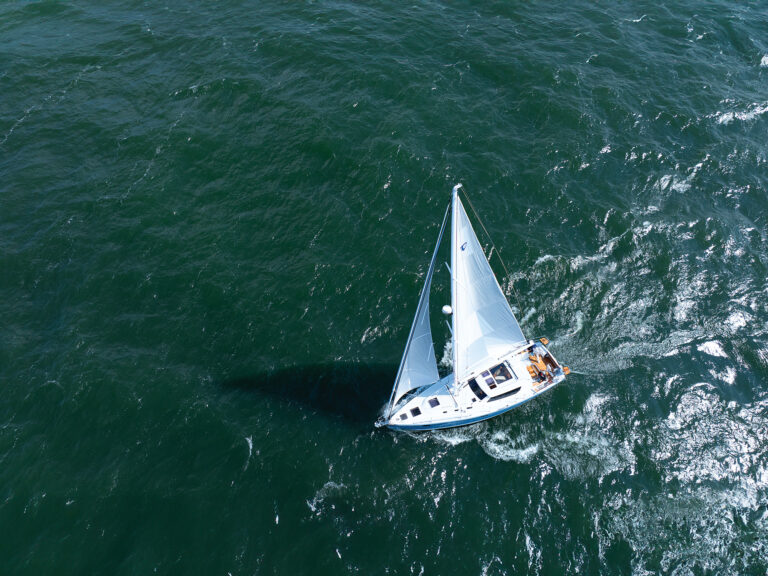

Sailboat Review: Tartan 455

Miracle in a Bowl
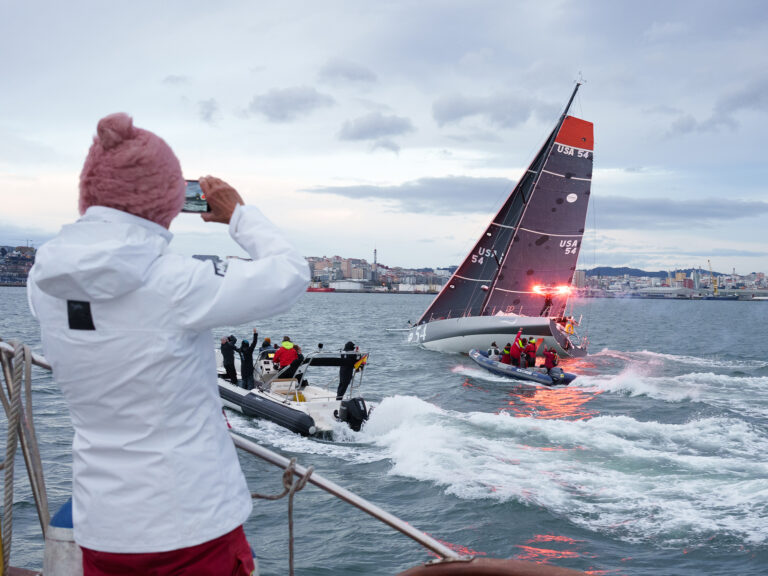
Cole Brauer Completes the Global Solo Challenge
- Digital Edition
- Customer Service
- Privacy Policy
- Email Newsletters
- Cruising World
- Sailing World
- Salt Water Sportsman
- Sport Fishing
- Wakeboarding
Weather Forecast
2:00 pm, 06/12: -11°C - Partly Cloudy
2:00 am, 07/12: -4°C - Clear
2:00 pm, 07/12: -7°C - Partly Cloudy
2:00 am, 08/12: -3°C - Overcast
- Cruising Compass
- Multihulls Today
- Advertising & Rates
- Author Guidelines

British Builder Southerly Yachts Saved by New Owners

Introducing the New Twin-Keel, Deck Saloon Sirius 40DS

New 2024 Bavaria C50 Tour with Yacht Broker Ian Van Tuyl

Annapolis Sailboat Show 2023: 19 New Multihulls Previewed

2023 Newport International Boat Show Starts Today

Notes From the Annapolis Sailboat Show 2022

Energy Afloat: Lithium, Solar and Wind Are the Perfect Combination

Anatomy of a Tragedy at Sea

What if a Sailboat Hits a Whale?!?

Update on the Bitter End Yacht Club, Virgin Gorda, BVI

Charter in Puerto Rico. Enjoy Amazing Food, Music and Culture

With Charter Season Ahead, What’s Up in the BVI?

AIS Mystery: Ships Displaced and Strangely Circling

Holiday Sales. Garmin Marine Stuff up to 20% Off

- Blue Water Sailing
Choosing and Understanding Self-Steering Gear
A guide to equipping your boat with an electronic autopilot or windvane: Part I (published October 2013)
Since the earliest days of long-distance solo or shorthanded sailing, a variety of devices have been invented for holding a boat on her course without the need of a constant helmsman. One of the early—and for many boats, still useful—methods was called “sheet-to-tiller” steering, which balanced the forces on a mainsail’s sheet against a spring or shock cord to steer the tiller in the appropriate direction when the boat would heel and reverse the direction when she would start to round up. This is obviously a delicate balance that required careful and often time-consuming readjustment when a course change or wind shift occurred.
Along with sheet-to-tiller steering came windvanes, which use a variety of methods to transfer a course change into a rudder angle using various paddles or vanes attached at the stern of the boat. Then, with the dawning of reliable electronics came motor-driven electric “autopilots” with a variety of methods for operation and all with the requirement for electric power and various instrumentation sources.
Today, a dizzying array of self-steering gear exists and it’s often difficult to know where to start. Some kits costs more than a small boat, and others can be made or cobbled together from spare parts in a garage. But by understanding the principles, major options, advantages and caveats of the various gear on the market, a prudent skipper can choose the right self-steering gear for his or her boat with confidence, knowing it will suit the boat in all conditions.
MAJOR CONSIDERATIONS The major questions and choices when faced with the purchase of new self-steering gear are: What conditions the unit is expected to perform in; what are the possible failure modes, how to recover from them, and how to detect or prevent them when underway; whether to get an electronic unit, windvane or both; where to mount the components and how to attach them to the boat; and last but not least, how much should ongoing maintenance and the expected service life of the gear be considered?
I’ve listed the options in this order because the most important thing about self-steering gear is whether or not it suits the conditions it is expected to operate in, including whether or not it is a good match for the vessel. The decision between an electronic autopilot and a windvane can only be made when a skipper decides these other issues first. After that, the decision becomes a technical one between models and options.
In order to help the skipper understand which equipment makes a good match for what conditions and vessel, it’s helpful to go into some detail on the various components and options available. So in this first of two articles on the topic, let’s dive more deeply into the realm of the electronic autopilot.
WHY CHOOSE AN ELECTRONIC AUTOPILOT? Since ships started installing electrical equipment onboard, the electronic autopilot has become a go-to self-steering device for both sailors and powerboaters alike. Combined with an electric or optical compass, all an autopilot needs to keep a boat on a constant magnetic heading is electric power. With the advent of data networks aboard, wind and GPS instrumentation can be combined with the autopilot to steer to waypoints, maintain a constant wind angle like a wind vane, steer specific patterns in the sea (e.g. circles, grids, or holding position for fishing or search-and-rescue), and perform many other clever tricks that a simple wind vane cannot do. And, of course, the electronic autopilot can do all of this whether or not the wind is blowing. As a result, electronic autopilots are nearly ubiquitous on most modern sailboats.
Electronic autopilots require three main components: a drive unit, a compass—usually called a “fluxgate compass” or for short, “fluxgate”—and a processing module, or “brain”. The processing module may or may not require a separate display and control interface, or it may incorporate it directly, and any or all of these components may be included in the same physical device. Make sure your autopilot package includes all of them though, or you may have to spend significantly more money later.
There are two major categories of electronic autopilots and quite a variety of options within those categories. The differences are crucial to your boat and to the system’s reliability, so it pays to at least take a cursory glance at some of these important details.
TILLER AND WHEEL PILOTS The most common category on small boats, a tiller or wheel pilot is an electronic motor attached to either a sliding lever or a spinning gear that is connected to the ship’s own tiller or wheel to physically move the boat’s rudder. Simple to install and easy to understand, these are typically the least expensive devices and are usually only reliable up to a certain amount of rough sea conditions, after which they often don’t have the power to keep handling the helm. In addition, they are constantly exposed to salt spray, and attachment and dismounting results in a certain amount of wear and tear over time. However, they are simple to understand and use and for smaller boats are often perfectly sufficient as long as the expectations on the system are reasonable. There are a few wheel units these days that have been used with success in heavy seas offshore, but they are rare and require a well balanced or easily helmed boat and are subject to limitations on rudder size and force.
Tiller and wheel pilots often, but not always, integrate the processing module and the drive unit in the same housing, simplifying use even further. They do not, however, offer anything in the way of redundancy over and above a ship’s own steering system, as they are dependent on that very system to perform their job.
Often, a skipper will fit a tiller or wheel pilot as a backup to a windvane when they decide that a wind vane is most suitable for their vessel.
BELOWDECKS PILOTS The common “upgrade” on a tiller or wheel pilot is to affix a control system belowdecks, often directly to the rudderstock itself as a backup to the ship’s main steering cables or tiller. This provides a degree of redundancy as well as protecting the main drive unit from the elements. In addition, because the system is permanently mounted, a larger and more durable motor and connection system can be fitted if desired, further increasing the reliability of the installation.
There are a variety of methods to attach these pilots to the rudderstock. The one you choose will likely be dictated by the type of steering your vessel already has, although you may have some choices between a few similar options.
For sailboats, the most common drive types are either rotary gear drive or linear drive. As the name suggests, rotary gear drive mechanisms have a motor with a reduction gear that, through a heavy chain, spins another gear affixed to the rudder shaft, similar to how a bicycle’s pedals spin the rear wheel through a pair of gears and a chain. Linear drive units work like a tiller pilot in that they extend or retract an arm that is affixed to a steering quadrant belowdecks. These can either use the existing quadrant on a rudderstock, or a special quadrant or lever arm can be bolted to the rudderstock specifically for the autopilot, like a miniature tiller belowdecks. Rotary gear systems are typically used with ships that have worm gear steering or similar solid-shaft coupling between a wheel and the rudderstock. Linear drives are more commonly used with cable steering.
There is usually only one option for boats with hydraulic steering, and that is an electronic hydraulic pump controlled by your autopilot. These can require special care during installation depending on if the existing system has proper backflow valves to allow for secondary control or not, and may require interlocks to be installed to prevent simultaneous operation of both hydraulic drivers at once. This is beyond the scope of this article though, so consult a knowledgeable steering gear installer for assistance with your particular hydraulic setup.
INSTALLATION CONSIDERATIONS Autopilots require careful mounting consideration, as the forces involved can be tremendous. Since modern belowdecks electronic pilots turn the main rudder directly they are subjected to the full force of the rudder, which, on a downwind run in heavy seas, can be severe. The mounting and rudder attachment for the drive unit is therefore critical and can involve construction of new structural framing, modification of the rudderstock to handle the additional loads or other significant rearrangements of existing equipment.
Mounting the processing module is less critical, but the display units definitely need to be accessible from the helm, and often, to maximize use of the self-steering gear, a belowdecks display and control station can duplicate what is at the helm.
Something to keep in mind with electronic autopilots is that, given the forces involved, they can require a substantial amount of energy to operate. As the seas get heavier, the unit has to work harder, which means the energy used by an autopilot increases. It is important then to pay close attention to your energy supply early and to monitor it more often as the seas build.
COMMON FAILURE MODES Electronic autopilots, while often quite reliable, are still mechanical and electrical devices and as such, have failures. Apart from the obvious need for a continuous and copious electrical power supply, they work with very delicate compass sensors and many types of drive units can be subjected to the wear and tear of every rudder movement whether they are in use or not. A failure in any one of these components can render the autopilot unable to operate, and failures in fluxgate compasses tend to be more common than manufacturers would like to admit. Also, wiring itself is subject to corrosion, accidental disconnection and chafe. All it takes is for a single control or power wire to become disconnected at the wrong time, say in heavy wind and a following sea, or when close to and passing a large vessel in a narrow channel, and the boat can be put in a dangerous situation very quickly. Thus, a prudent sailor treats the electronic autopilot like any other piece of gear and plans for failure while maintaining the equipment to the fullest.
One surprising failure mode I have had the misfortune to observe firsthand is with a hydraulic autopilot that was a separate system from a hydraulically steered boat. The systems worked perfectly when used independently and offered 100 percent redundancy in control—at least, as long as the boat had power and the rudder remained intact. But when the autopilot was engaged and the helm was touched by someone, the two immensely powerful hydraulic rams fought each other and the resulting back and forth vibration and side loading destroyed a rudder bearing in very short order. So it pays to have interlocks installed when other hydraulic steering systems may be in place simultaneously with a hydraulic autopilot.
Look for Part II in the November issue of BWS where we will cover windvane self-steering in detail, and consider how to best determine what you should be equipping on your own vessel.
Daniel Collins, an ASA certified sailing and navigation instructor, amateur extra class radio operator and small boat racer, enjoys experimenting with marine electronics. He is also actively involved in community-driven social change. Email him at [email protected] , or read his blog at www.oddasea.com .
Author: Daniel Collins

- Construction
- Customer Reviews
- Pictures & Videos
- How it Works
- Rudder Links
- Servo Power
Neptune Servo Pendulum Windvane
Effective | reliable | safe | hassle free.

Yt. Shangri-La rounding Cape Horn

Trade Winds

Why a Neptune Servo Pendulum Windvane?
The Neptune Windvane works on a horizontal axis servo pendulum system. A servo pendulum windvane uses its own rudder, together with the yacht steering system, to keep the boat on course. A servo pendulum windvane is the most efficient form of yacht windvane self-steering available.
Neptune works well when motoring as long as the wind across the decks is above 5 knots. This is a big + and only possible as the mechanism has almost zero friction . The Neptune windvane is simple to operate!
It connects to the yacht’s existing wheel or tiller steering system and, once set, keeps the yacht on course. Any change in wind direction, or deviation from course, causes a movement of the Neptune’s windvane. These movements are transmitted both to the Neptune’s own rudder and to the yacht’s steering system, bringing the yacht effortlessly back on course.

We lovingly hand-build each Neptune servo pendulum windvane from the highest quality materials to ensure you enjoy many years of reliable self steering.
The Neptune build quality, together with the simplicity of a servo pendulum windvane, make it the ideal choice for a safe yacht passage. Read more about the construction of a Neptune servo pendulum windvane

We offer four models of the Neptune servo pendulum windvane to cater for yachts from 23ft (7m) to 50ft (15m). Read more about the Neptune servo pendulum windvane range

Naturally we believe that our Neptune servo pendulum windvane is just the best on the market.
Don’t just take our word for it, hear what our happy customers have to say.
You are using an outdated browser. Upgrade your browser today or install Google Chrome Frame to better experience this site.

Vanes and the Sliding Rig
by A. R. Lassell
On Sailing with Vane and Sliding Rig
A Lassel sliding rig, with the running rigging in color. The main sheet is in red and the jib sheet is in blue . The bowsers were spring clips that slid on the center rod. There was a fairlead on the mast step for the main sheet. The jib sheet had a “vernier” bowser on the very front.
We assume that your model yacht is equipped with vane steering gear and sliding rig, on which the sheets are rove [threaded — Ed.] so that one bowser simultaneously controls the set of the two sails. That bowser has been called the “Synchronous Bowser.” The standing parts of the sheets are sliding with the rig and are attached to either a jamming ring or an adjustment bowser. The main sheet is single-rove, but the jib-sheet is double-rove through a fairleader approximately half the distance to its jib-tack swivel as compared with the corresponding elements of the main sail, which results in both the boom and the club maintaining about the same angular speed as the synchronous bowser is being moved.
The major axis of the pond is assumed to be parallel to the wind, and that we experience a beat to windward at the onset of our adventure in sailing. So, we proceed to set the yacht to sail close-hauled.
Our immediate attention is to set the two sails in a definite relation to each other. The ever-present measuring means, finger-breadth, is used so as to improve on mere guessing. We haul in on the synchronous bowser snug, bringing the boom in about midships, and ease up on the jib sheet adjustment so that there is a space equal to three fingerbreadths between the mast and the clew of the jib, in the case of an “M;” for a “X,” four units and for an “A” more commesurably with the length of its club. This set would be suitable for a 14-mile wind; in stronger winds, haul the synchronous bowser tight, not just snug. In lighter winds, ease up on the bowser in steps corresponding to the gradual decrease so, that in drifting zephyrs, the bowser has moved an inch from its original place.
If the yacht would then be picked up and headed into the wind, the sails should begin to luff at the same time. Preferably, the jib should luff before the main, and, particularly, its upper corner, the head, should have its belly deflated in the first stage of luffing. To maintain that deflation is the ideal of steering; it is the consumamation of the skills in design and yachtsmanship; it is the best possible index of your proficiency. Watch that index!
A parallel aboard a full-rigged ship, as a guide for the helmsman, is the action of the wind at the weather corner of the mizzen royal (the topmost sail on the aftmost mast). The yards are braced around in a high-pitched spiral, so that the higher the sail, the earlier it luffs upon the ship heading into the wind. The helmsman keeps that corner deflated, no more, no less, and days on end, in the South-East Tradewinds, where the winds are constant.
Not blessed with such winds on our ponds, we have to put up with up-drafts and down-drafts. To preserve his assurance, the skipper must evaluate the vagaries of a down-draft realistically. If such a jet is being funnelled down to the surface of the pond, it ruffles up and darkens the pond’s surface, and fans out. Thus if two yachts are sailing in the same lane but some feet apart [and] encounter such a [flow] centering between them, the leader will head up and the other will pay off with reference to the course sailed the moment before. So, that [incident] was just one of those things, and there is no need for new sails, fuller garboards, smaller skeg, or larger rudder.
A detailed drawing of a Lassell sliding rig for the M class “Sun Kiss.” The nearside side horse is not shown. All rods are 1/8-in stainless except for the side horses, which are 3/16. Click on the picture for a (much) larger view. It will come up in most browsers as a blank screen. Don’t panic, just slide the window around until you start finding parts of the drawing.
The next thing to come to our attention is the sliding rig. It is an adjunct to the vane steering gear, which, by no means, all-sufficient. The rig is set to correspond to the lightest wind on the windward board [lap — Ed.] With an increase in the wind, the rig is moved ahead, and the spaces traversed in sympathy with the wind resemble the D-scale of a sliderule [i.e., decrease logarithmic scale — Ed.] The seven-inch scope allotted is rarely enough, the idea being that went the forward end has been reached, it is time to reduce the main sail. Should the rig lack scope in the aftermost position, lee helm must be used, but such an expediency is only justified to [compensate for] this limited deficiency. Lack of scope in the foremost position calls for stepping the jib farther ahead, or, as a last resort, for the sheeting in on this sail for the purpose of tipping the center of effort ahead; in other words: “choking her to death.” However, the sensible thing to do would be to start reefing the main. Equally sensible, perhaps, would be the striking of the jib instead of using lee helm in a drifting match.
The sliding rig affords a quick means of “tuning up,” and re-tuning to conform to the wind changes. The skipper should develop a built in aerometer [wind speed indicator — Ed.] behind his eyes; it gives him assurance. If the jib, by shaking too frequently, announces that the yacht is trying to lie to close to the wind, slide the rig ahead half an inch or so; if it stays “asleep,” slide the rig aft until an occasional deflation takes place.
As our system of sailing has been outlined, it differs from the usual “toyboat sailing” in as much as in this case the jib sheeted so as to tip the center of effort either ahead or aft. This system, although having limited merit, fails when the strength of of the wind requires sheeting the jib flat amidships and, often, easing up on the main. The spectacle, here, is an excessive heel, no snap, and an inordinate induced drag caused by side-slipping.
The Lassel vane with parts marked.
Next the vane has to be set. The self-tacking gear is assumed. It has five “triggers:” the Locking Latch, the Plunger, the Symmetry Adjustment, the Cams, and the Tension Slide on the oscillator arm. [All parts mentioned in this essay are amarked on the accompanying illustration — Ed.]
The latch either locks the “Seattle Bar” (the combined friction clutch and oscillator bracket) to the vane-disc or to the vane-frame. The latch, down and locked to the disc, aligns the Seattle Bar ideally with the center-plane of the yacht and allows the flip-flop of the feather assembly, sot that the leading edge of the feather may look into the wind’s eye over either bow without manual intervention. This ability of the gear to set itself as the yacht is tacked justifies the designation, self-tacking vane.
The latch, hinged up and straddling the lug on the feather frame, locks the latter to the Seattle Bar, which, through its friction clutch, transmits the torque from the feather to the vane-arm. That expediency is used in sailing all courses other than lying close; even preferable in sailing full and by. [On a broad reach, that is, across the wind — Ed.]
The latch, hinged up without straddling the lug, is used in effecting a “quick gye.” In a gye, the yacht heaves about without direct help from her handlers. The procedure is to raise the latch, before turning the yacht about, so that the flip flop of the feather is impeded in its full-amplitude travel, then the yacht is put about low in the wind so that she may gain momentum ample for the maneuver. The quick or short guy will give the yacht eight or ten feet of offing, which may enable the yacht to fetch the finishing line without sailing the width of the pond.
In the middle of the Seattle Bar, there is a screw adjustment that actuates the Plunger. The purpose of it is [to provide] a means of controlling the angular scope in the two and fro movement of the feather frame. At its widest amplitude, the angle is a bit less than 45 degrees on each side of center. Since the apparent wind over the deck has a lesster angle of incidence, the wide amplitude set produces weather helm normally. That’s how it should be, for the need of weather helm means that the center of effort is aft enough to allow the yacht to coast through a dead spot with a reduced chance of yawing (wandering off to leeward). In this situation: no wind and therefore no torque on the tiller; none need since the center of effort takes over the steering.
In order to produce less weather helm, neutral- and finally, lee-helm, the plunger is moved out by backing up on the adjustment screw. If the winds over our ponds were as constant as the South-East Tradewinds, neutral helm would be the thing, and lee helm sailing would the additional charm of a way of checating the sail-area limitation, for the feather, then, would be acting as an unmeasured mizzen sail. When the center of effort is too far forward, lee helm must be used to make the yacht head up. In the absence of steerage way, the yacht can’t head up; the misplaced center of effort takes charge, and she yaws. The vane given control again, she slams into the wind and completes the cycle of aberration by losing steerage once more.
Not much is known of a recommendable minimum angle of seting the vane in close-hauled sailing. However, one certain yacht, using lee helm at a 30 degree vane setting, always lost her race as she paid off in an updraft, while her competitor held her course. Another one, with extreme lee helm (11 degrees), in similar situation, failed to get back on her course for lack of space. Prudence, therefore, would suggest a 3-point (33 degree) minimum.
The symmetry adjustment is provided as a means of making the yacht point equally on both tacks. The sure way of gauging this equality is by observing the lifting of the jib. “Lifting” is the sea-going expression for the deflation mentioned before. The procedure is: if she is sailing low on the wind while on the starboard tack, as compared with lying on port, turn the adjustment screw left-handedly; low on port, righthandedly. Two turns, if the difference is obvious.
After we have achieved symmetry, occasion might arise when a lopsidedness is desirable. Ability to point higher on one tack than the other is brought about by means of the proper Cam, [Check the caption under the drawing on the issue of the Cams — Ed.] on the plunger, being rotated so as to restrict the amplitude of the oscillator to leeward of the outbound tack. Used for gying; particularly, in slowing up the quick gye. Its efficacy, limited.
The Tension Slide on the oscillator functions as a means of attaching one end of one or more rubber bands and of adjusting the tension of these so that, when the inertia of the counterweight becomes disturbed, the elasticity of the rubber causes the yacht to heave about. A heading puff, a wave, or a “dead spot” can be the triggering agent. In the use of this “long gye,” there is always an element of suspense, and the skipper who converts 100 per cent is a wizard. But such wizardry is not dependent on the skipper alone; the yacht has to be designed for it, but MYRAA does not permit recessive leading edges of keels. [Lassel here is referrring to the “non-prognauthous” keel clause of the M Class rules, which forbade any lower part of the keel being ahead of any upper part. In his experiments, Lassel had devised what he called the “finless fin keel,” (see the illustration in the history section) which was much more maneuverable than the traditional fin and skeg mandated by the rules. The restriction was lifted by the AMYA, but is part of the Vintage M Class rules.]
We assume now that the windward passage has been made. The return trip will be done with the latch straddling the locking lug, and with the resulting locked complex rotated so that the leading edge of the feather looks into the wind’s eye 180 degrees from the position that brought the yacht to windward. That generalization does not pertain if the yacht had been tacked, for the new position would be 180 degrees from the [median] of the tacking positions, namely, directly or nearly above the vane-arm. Neither does it pertain to exactitude of any course to be steered, for an “overtrim” is needed, and this depends on the yacht’s behavior characteristics in variations of the wind strength. As a rule, the stronger the wind, the more overtrim.
The vane-disc is calibrated like a compass card. The total number of marks or points is 32; eight to a quadrant. For our purpose, the quadrants must be named, and the designations might just as well be derived from the general course sailed when the latch is over the quadrant. Thus, the latch over the port forward quadrant would be: Port Broad Reach. To this should be added the number of points, counted from the forward center of the disc. As an example: five points, port broad reach. Under certain wind conditions, that would be the setting for a return trip after the yacht had fetched the turning line while lying close on port tack and without having tacked. Four of these points represent the ideal 180 degrees, and the fifth, the overtrim.
The term “on the port tack” means that, if the mainsail were a square sail, it would be necessary to hold down the lower weather corner by means of a tackle on the port bulwarks, when the wind was coming over the port bow. In our specific situation, the boom would be over the starboard counter, and the latch of he vane, theoretically or actually, over [the] “Starboard Close Reach” quadrant. A theoretical 3 1/2 points for close hauled, if the latch were down in the recess; actual 4 points for full and by, and 4 to eight points for close reach, with the latch up.
The sailing at certain angles with the wind, other than lying close, we shall call “sailing courses,” and forget that the term connotes compass courses. For the sake of preserving his poise, the skipper should know how to sail, both in light and heavy going, certain fundamental courses like full and by, wind abeam, the reverse of lying close, and directly before the wind.
For instance, he can expect to have set the vane at 6 1/2 points, close reach, to sail wind abeam in light airs, while 8 points would be indicated in a 20-mile wind. Directly before the wind, if the boom is out on starboard side, one or two points on port broad reach would be the setting. In this case, the kicking strap on the boom should be hooked over to starboard to prevent unauthorized jibing. Should she jibe, her new course would be at least three points off he attempted course.
How are the sails to be set? So that the sails don’t spill the wind, on the yacht getting two points off her course. That, on broad reaching and running. If the skipper must gamble, a full spinnaker gives him that opportunity, otherwise, a flat one is suggested, for it is easier to keep filled.
In order to correct the steering on the leeward board, “Squeeze her to you” is a simple rule to follow. “Her” refers to the feather-bar complex, and “squeeze” to its rotation toward the lee shore and “too you,” in an assumed position abaft the vane. A squeeze amounting to one point is rarely enough, even if the angle of approach was sharp; it is supposed to be a result of the venturi-effect.
The writer was commissioned to write concise instructions without using salty terms. Consiseness does not mean brevity, but implies an unadorned treatment of important points. All arts and sciences have their own terminologies; yachtmanship can’t get along without its.
- {{>productsMenu}} Products
- {{>trendsMenu}} News & Trends
- Equipment >
- Marine Electronics >
- Sailboat wind vane self-steering system
Sailboat wind vane self-steering systems
- My filters for sailboats Delete all
Manufacturers
- Cape Horn (2)
- Scanmar International (4)
& reach your clients in one place, all year round
{{product.productLabel}} {{product.model}}
{{#each product.specData:i}} {{name}} : {{value}} {{#i!=(product.specData.length-1)}} {{/end}} {{/each}}
{{{product.idpText}}}

sailboat wind vane self-steering system Monitor
Introduction Monitor—The Self Steering Solution There are many different systems of windvane self - steering . Trim tab, auxiliary rudder and servo ...

sailboat wind vane self-steering system Auto-Helm
... boats under 50 feet. It is especially suited for boats with: Excessive play or friction in main steering system Hydraulic steering Wheel steering ...

sailboat wind vane self-steering system Saye's Rig
... Which Boats? The Saye’s Rig is suitable for many boats. It is the ideal self - steering gear for very large boats with traditional transoms and/or boats with: Hydraulic Steering High ...

sailboat wind vane self-steering system E-Rudder
... rudder, the E-Rudder emergency rudder system . The E-Rudder system converts a regular Monitor windvane into a proven emergency rudder system to safely get a crew and boat into port. Due ...

sailboat wind vane self-steering system Integrated
Integrated into the stern of the boat, the CapeHorn Self - Steering System becomes virtually as strong as the boat itself. A tube (called the Mounting Tube) is fibreglassed strongly to ...

sailboat wind vane self-steering system OUTBOARD
The Varuna and Joshua models combine the simplicity of the CapeHorn control mechanism, with a conventional installation mode, totally outboard. This allows installation of a CapeHorn on yachts with outboard rudders or in all cases when ...
Your suggestions for improvement:
Please specify:
Help us improve:
Receive regular updates on this section.
Please refer to our Privacy Policy for details on how NauticExpo processes your personal data.
- Wind vane self-steering systems
- Sailboat antennas
- Sailboat steering compasses
- Sailboat displays
- Sailboat wind vanes
- Sailboat software
- Sailboat radios
- Manufacturer account
- Buyer account
- Our services
- Newsletter subscription
- AboutVirtualExpo Group
Dyna-Ski Boats custom builds outboard powered water ski boats for recreational skiers and show ski clubs. We have customers all over the world including Malaysia, the Caribbean, Moscow, Russia, the Cayman Islands and Canada. This blog is used to keep readers informed about what is going on at Dyna-Ski and answers questions that are frequently asked. You can also visit www.dyna-ski.com for more information about our boats. Contact Dyna-Ski at [email protected] or call 715-854-7501.
Thursday, June 18, 2015
Upgrading to evinrude digital controls.

No comments:
Post a comment.
Sunrise Yachts Sponsor 2011 Moscow International Boat Show (MIBS)
- Inspiration
Related News
Popular news this week, popular news this month, latest news.
- Yacht Charter & Superyacht News >
Written by Mike Smith
Sunrise Yachts, a luxury yacht building company which is based in Turkey, has been made a main sponsor of next year’s 2011 Moscow International Boat Show (MIBS). The four-day Russian yacht show event is currently scheduled to run from April 14-17 at the Moscow’s Crocus exhibition centre.
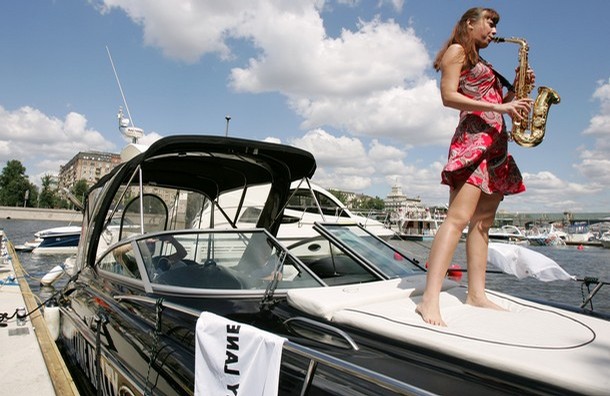
moscow boat show
MIBS is organised by the ITE Group and it is one of Russia’s leading boat shows and is an internationally recognised superyacht event. The show covering everything from small parts and accessories to large superyacht with over 9,000 people and 178 exhibitors attended the last year show.
The Paolo Scanu-designed Sunrise 45 yacht is an ocean-going cruising yacht that was released in 2009 to much acclaim at this was the group’s first-ever model.
Sunrise Yachts was founded in 2007 by the German entrepreneur Herbert P Baum along with the French-British yacht builder Guillaume Roché. The luxury yacht group is based in Antalya, Turkey and utilises a 10,000sq m shipyard facility. Sunrise has two sheds measuring 100m (328ft) x 16m (53ft), as well as a 70m (230ft) x 16m (53ft) fully acclimatized paint shed that can accommodate new-build and refit projects up to 65m (213ft) in length and 1,200 tonnes displacement.
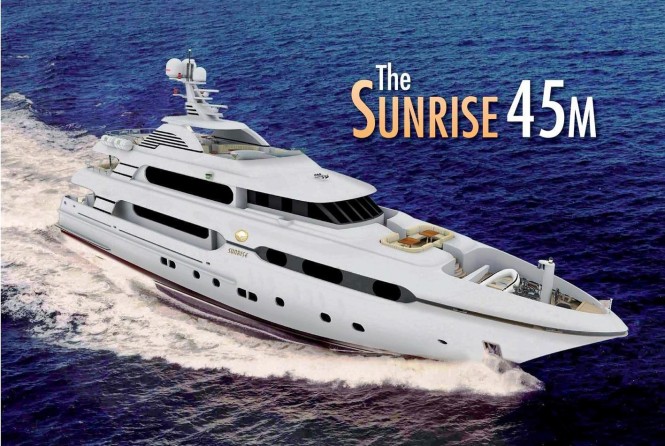
The sunrise 45m superyacht by Sunrise Yachts
Along each side of the yacht-building facility, space is available for long-term sub-contractors with the latest equipment and logistics capabilities, along with air-conditioned storage, ventilation and extraction plants. The shipyard is organized as an “assembler,” based loosely on the car industry’s model, with a small, yet powerful project management team charged with running all the in-house long-term sub-contractors.
Please contact CharterWorld - the luxury yacht charter specialist - for more on superyacht news item "Sunrise Yachts Sponsor 2011 Moscow International Boat Show (MIBS)".
- Charity & Fund Raising
- CharterWorld News
- Classic Yachts
- Coronavirus
- Cruise Ship
- Ecological Yachts
- Expedition Yachts
- Expert Broker Advice
- Feature Superyachts
- Interior Design
- Legal & VAT Yacht Issues
- Luxury Catamarans
- Luxury Gulet
- Luxury Phinisi
- Luxury Trimarans
- Luxury Yacht Design
- Luxury Yachts
- Marinas & Harbours
- Marine Ecology
- Marine Electronics
- Marine Equipment
- Mega Yachts
- Modern Yachts
- Motor Yachts
- New Launch Yachts
- New To Charter
- Open Style Sports Yachts
- Private Jets
- Sailing Yachts
- Social Media
- Sports Yachts
- Superyacht Crew
- Superyacht Photographers
- Superyacht Products & Supplies
- Superyacht Refits
- Superyacht Reviews
- Superyachts
- Uncategorized
- Yacht Builders
- Yacht Charter
- Yacht Charter Destinations
- Yacht Charter Picks
- Yacht Charter Specials
- Yacht Delivered to Owner
- Yacht Designers
- Yacht Events & Boat Shows
- Yacht Fashion
- Yacht Industry News
- Yacht Photos
- Yacht Racing
- Yacht Racing & Regattas
- Yacht Safety Equipment
- Yacht Support Vessels
- Yacht Tenders
- Yacht Videos
- Yachting Associations
- Yachting Awards
- Yachting Business
- Yachts For Charter
- Yachts For Sale
Quick Enquiry
Superyacht news:.
Email Your Yachting News to: news @ charterworld.com
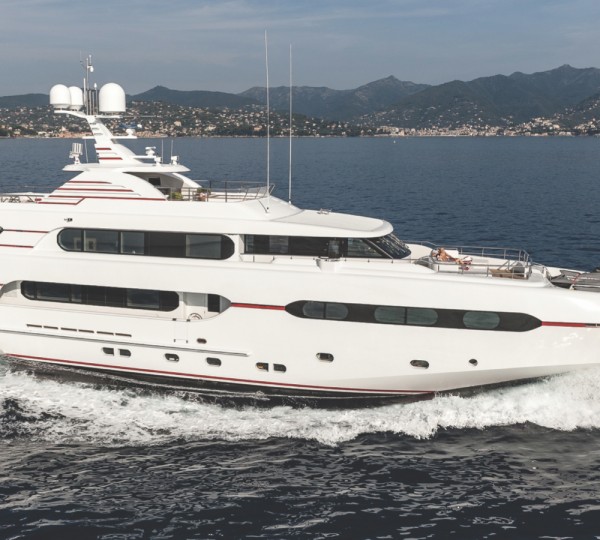
Sunrise Yachts
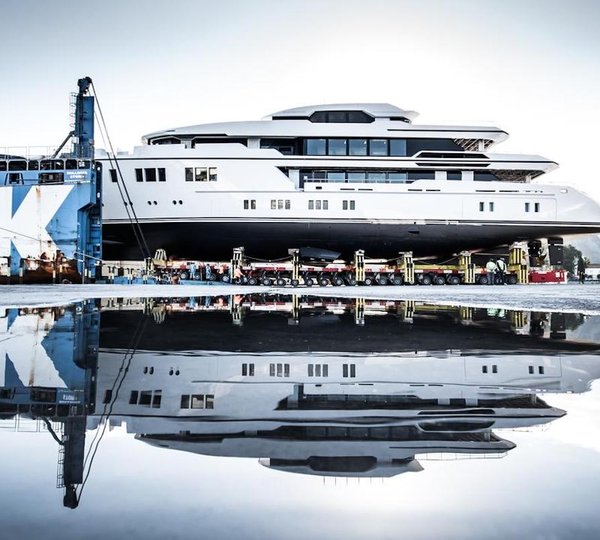
63M CUSTOM SUPERYACHT
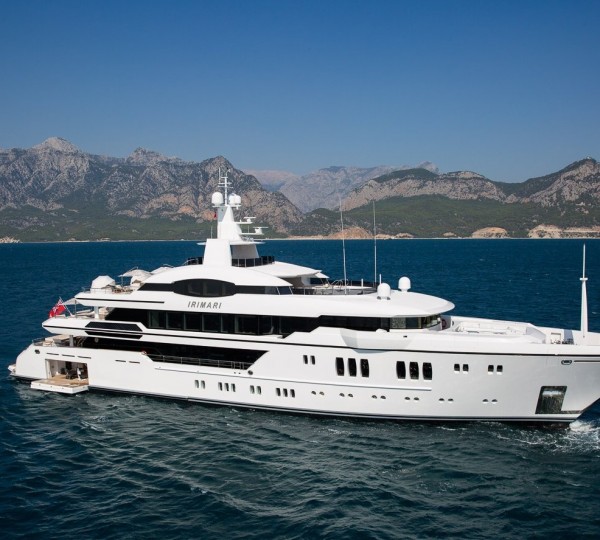
5th Moscow Boat Show, March 20-25, 2012
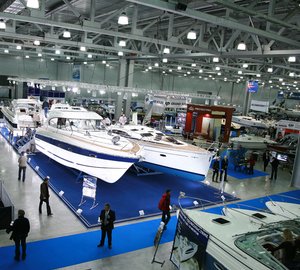
5th International exhibition of boats and yachts Moscow Boat Show a Huge Success
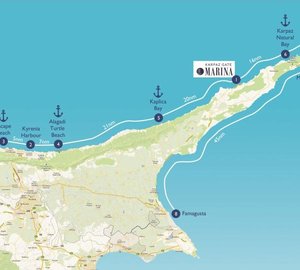
New Savings and Benefits for Russian Yacht Owners in 2014 announced by Karpaz Gate Marina
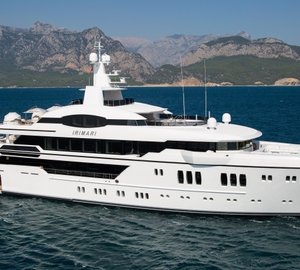
Recently delivered 63m Sunrise Super Yacht IRIMARI to make world premiere at MYS 2015
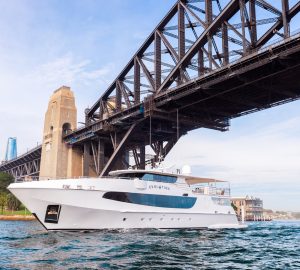
39m luxury yacht EVOLUTION for charter on Australia’s east coast
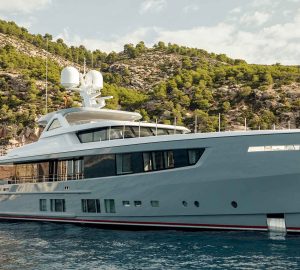
Charter Special on board 36m luxury yacht CALYPSO I from Italy to Greece
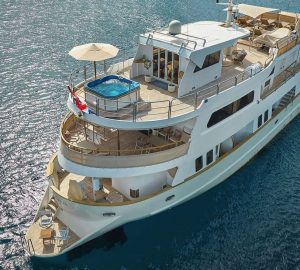
Croatian charter yacht LA PERLA offering 10% discount on exclusive vacations in the Adriatic
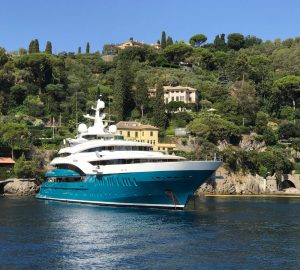
Charter a yacht during the Monaco Historic and F1 Grand Prix festivals and soak up the atmosphere from on deck
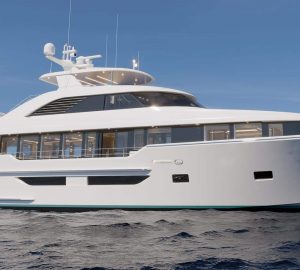
Westport announce the first hull of their 36m W117 range is nearing completion

Superyacht LAUNCHPAD previously Feadship 1010 delivered
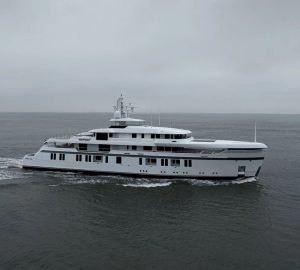
65m Feadship superyacht PROMISE.D delivered
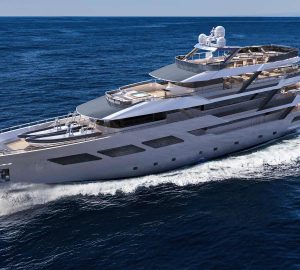
Discover our Top 10 brand new yachts available for charter worldwide this year
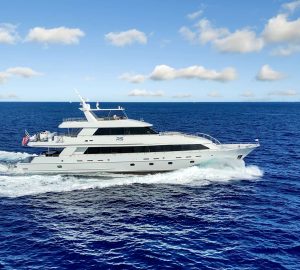
Florida charter yacht REAL SUMMERTIME offering 10% discount
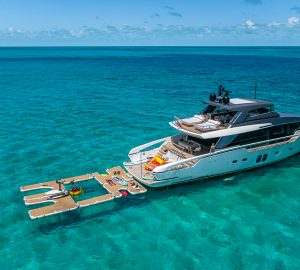
Discover summer in New England aboard a luxury charter yacht: Escape to this beautiful northeast corner of the USA
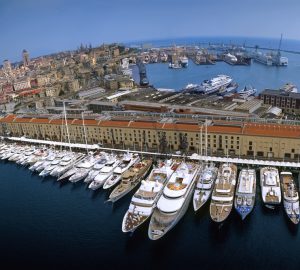
Looking ahead to the 2024 MYBA Charter Show in Genoa
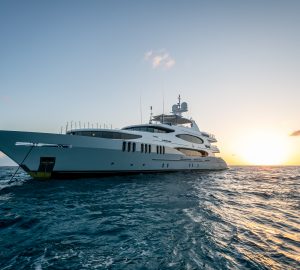
Last minute yacht charter deals in the Bahamas
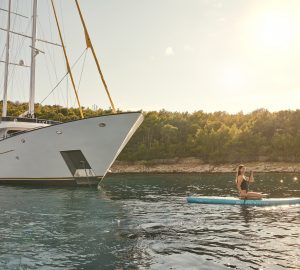
49m sailing yacht ANIMA MARIS is offering discounted rates for the remaining summer weeks in Croatia


Video: drifting in Moscow
According to the tome of Internet knowledge that is Wikipedia, Art ‘is the product or process of deliberately arranging items in a way that influences and affects one of more of the senses'.
We're not sure you can correctly define ‘art', but somehow know that this video is ‘it'; a pair of old, racing-liveried Nissans (200SX pick-up and Silvia), sliding gloriously around the streets of the seventh largest city on our planet.
They're driven by Evgeniy Satyukov and Geprgiy Stepanyan who came first and second in the 2010 Russian Drift Series; chaps who appear to have an umbilical connection to sideways lunacy. Enjoy.
You might like

Renault boss calls for more small cars and better charging in 'Letter to Europe'

This is the new Audi Q6 e-tron, with prices starting from £69k

Does the bZ4X look cool now that it's got vintage Toyota stripes?
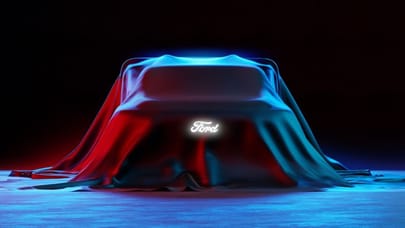
Ford is taking a heavily modified version of its F-150 Lightning to Pikes Peak
Top gear newsletter.
Thank you for subscribing to our newsletter. Look out for your regular round-up of news, reviews and offers in your inbox.
Get all the latest news, reviews and exclusives, direct to your inbox.

Get your car MOT-ready with eBay

Tesla Cybertruck

These are the 12 best hot hatches of all time

Top Gear's top 20 electric cars
More from top gear, trending this week, mercedes has stuck its four-cylinder a45 engine into the amg gt, used small electric cars: eight of the best, google maps wants to tell you the ideal speed to drive to prevent 'ghost' traffic, the mercedes vision eqxx has smashed its own efficiency record, subscribe to the top gear newsletter.
By clicking subscribe, you agree to receive news, promotions and offers by email from Top Gear and BBC Studios. Your information will be used in accordance with our privacy policy .
Sorry, something went wrong

Try BBC Top Gear Magazine

IMAGES
VIDEO
COMMENTS
How to sail using Brain automatic steering gear.
Self-steering gear is equipment used on sail boats to maintain a chosen course or point of sail without constant human action. History. Mechanical or "wind vane" self-steering started out as a way to keep model sail boats on course. Before the advent of radio control, model yacht racing (started before WW1) was typically contested on long ...
If you wonder how model yachts sailed before the days of radio control, the answer was: quite nicely, thank you. This was called "free sailing", ... The vane gear for self-steering was invented by Nathanael Herreshoff in 1875. The idea laid more or less dormant in both model and full-scale practice.
THE earliest model yachts had no steering gear whatsoever, and consequently were unable to sail a good course when the wind was anywhere abaft the beam. The first steering gears to come into use were weighted rudders, and though these were better than nothing at all, it was not until 1906 that the first efficient steering gear was invented. ...
vintage free sailing model pond yacht with vane steering gear. Free sailing 1940s MM or Half Marblehead Class racing yacht by Grove Pond Yachts. A small 25in hard chine yacht with a beech ply hull and deck, aluminum mast and cambric cotton sails. She is fitted with our own Vane steering gear that keeps her on course even in 10-15 knots of wind.
Address: Köömne 18, Tallinn, Estonia 10617. E-mail: [email protected]. Phone and WhatsApp: +372 5667 6656. If you are a human seeing this field, please leave it empty. Windy's self steering gear will make your sailing experience more enjoyable. Windy is a strong, efficient, and reliable shipmate. Windy has proven itself responsive in light ...
The Ultimate in Sailboat Mechanical Self-Steering. Custom Design and Manufacturing. Worldwide sales. Factory Direct Since 1974. San Diego, California, United States. www.sailomat.com [email protected]. SAILOMAT is the world's leading professional design team and manufacturer specializing in state-of-the-art mechanical self-steering systems ...
Both self-steering methods relied on rig and hull balance for this. Boats equipped with Braine gear sail to windward on rig balance alone. Boats equipped with self-tacking vane gear have a limited ability to correct for imbalance when going to windward; if the boat turns such that extreme weather
Autopilot, the first self-steering gear was introduced in the 1920's to control model yachts but it was not until 1948 that the principle was applied to full scale yachts. Standing at the helm for lengthy periods, monitoring instruments and keeping a good look out can be very tiring. An autopilot relieves the helmsman from steering the ...
The Basic Mechanics. The whole point of a wind vane steering gear is to provide feedback to the rudder so that the boat can remain at a set angle to the wind, 'in the groove'. This will not be a steady compass course but a constant point of sail. First you sail the boat on the desired compass heading. Then you trim and balance the sails for ...
The Hydrovane shaft assembly includes the shaft, the outer tube, and shaft bearings. Older units: The shaft outer diameter will be either 1 1/8 in (28.575 mm) - out of production since 2002 - or 1 ¼ in (31.75 mm). Since early 2009, all shafts are made of solid 1 ¼ in Ferrinox 225 'Super Duplex' stainless steel - three times as ...
Choosing and Understanding Self-Steering Gear. A guide to equipping your boat with an electronic autopilot or windvane: Part II (published November 2013) A common piece of equipment found on the modern offshore cruising sailboats is the autopilot. Whether it is an electronic unit, a windvane, or both, the need to relieve the helmsman from ...
SKU: MAR2863 Categories: Engineering, Marine, Sailing Boats & Yachts. Two sheets showing full working drawings for a variety of steering and sail control devices for vintage restored and replica yachts of all types.Most diagrams are fully dimensioned for reproduction by competent model makers.Designed by G W Clark. £ 17.00.
Wind Vane Steering for yachts was first developed as a practical device for model yacht races in the early thirties. In 1939 the French Transatlantic yachtsman, Marin Marie, evolved and made a full size vane gear while crossing the Atlantic from West to East in the 45' motor cruiser "Arielle". ... For yachts with free-running and fully self ...
The Auto Steer trim-tab vane is made of LM25 aluminum castings and 316 stainless steel, with insulation between dissimilar metals to minimize galvanic action. The manufacturer, Hydra Engineering, doesn t recommend the system for heavy-displacement boats over 35 feet. For larger boats, the company makes a more powerful servo-pendulum unit.
Choosing and Understanding Self-Steering Gear. September 19, 2014 Daniel Collins Blue Water Sailing. A guide to equipping your boat with an electronic autopilot or windvane: Part I (published October 2013) Since the earliest days of long-distance solo or shorthanded sailing, a variety of devices have been invented for holding a boat on her ...
A servo pendulum windvane uses its own rudder, together with the yacht steering system, to keep the boat on course. A servo pendulum windvane is the most efficient form of yacht windvane self-steering available. Neptune works well when motoring as long as the wind across the decks is above 5 knots. This is a big + and only possible as the ...
The next thing to come to our attention is the sliding rig. It is an adjunct to the vane steering gear, which, by no means, all-sufficient. The rig is set to correspond to the lightest wind on the windward board [lap — Ed.] With an increase in the wind, the rig is moved ahead, and the spaces traversed in sympathy with the wind resemble the D-scale of a sliderule [i.e., decrease logarithmic ...
sailboat wind vane self-steering system OUTBOARD. standard. Contact. The Varuna and Joshua models combine the simplicity of the CapeHorn control mechanism, with a conventional installation mode, totally outboard. This allows installation of a CapeHorn on yachts with outboard rudders or in all cases when ...
Dyna-Ski Boats custom builds outboard powered water ski boats for recreational skiers and show ski clubs. ... The small block V-6's (135 HO, 150, 150 HO,175 and 200) use one model of actuator. The big block 200 HO and up use another model. A laptop computer with special software and cable needs to be used to calibrate the system for a couple ...
The Paolo Scanu-designed Sunrise 45 yacht is an ocean-going cruising yacht that was released in 2009 to much acclaim at this was the group's first-ever model. Sunrise Yachts was founded in 2007 by the German entrepreneur Herbert P Baum along with the French-British yacht builder Guillaume Roché.
In 1961, the 407 was further upgraded with an even more powerful M-407D1-D2 engine (allowing to handle the fourth speed on a manual transmission), self-adjusting brake cylinders and hydraulic clutch drive, improved front suspension for easier driving, and a completely restructured dashboard. This model, manufactured as the Moskvitch 403, served ...
According to the tome of Internet knowledge that is Wikipedia, Art 'is the product or process of deliberately arranging items in a way that influences and affects one of more of the senses'.